#comic industry insights
Explore tagged Tumblr posts
Text
Ever wanted to read interviews with your favorite underground comics from three of your favorite underground publishers? Well, you can do that now in Outsider Comics! Featuring in-depth conversations with icons such as Melinda Gebbie, Jeff Smith, and Steve Rude, and more, each interview is a revealing look at the passion and dedication these creators bring to their craft.
Pick up a copy: https://www.amazon.com/dp/B0DM6JGXN9/
#comic books#graphic novels#pop culture#comic book creators#art#storytelling#comics history#interviews#essays#creative writing#BearManor Media#comics community#indie comics#comic book fans#Outsider Comics#comic industry insights#artist spotlight#comic artists#author interview#creator spotlight#comics journalism#new release#behind the scenes#creative process#must-read#collectors edition#comics publishing#book recommendation#comic lovers#fan culture
1 note
·
View note
Text
Just updating for the Hazbin Hotel AU I'm writing!

I'll be separating the comics into two categories in which:
× The main comic series focused on the story
× And the other revolving around Radioapple 📻🍎
ABOUT THIS AU:
MICHELIN STARS
is a Hazbin Hotel Restaurant AU where Charlie offered her help to Lucifer, until he agreed to let her manage the place, as to her perspective is that he does work hard, but always worked too much.
Charlie soon faces the hardship of running a business and macromanaging. With the inconsistent quality, increasing trouble in finance, unsatisfied customers: Nevertheless, doesn't stop her passion for food and has set a goal to bring success and life it needs, having the family business running and about with her most trusted employees in the mix! That is... Until the sketchy activities behind service. What a recipe for disaster~
-
In reality, Hotels and Restaurant management/service does not stray far from each other but rather work together. So, I figured of writing focusing on Food industry while not straying away from how it goes Canonically in the Hazbin Hotel Universe! ::)
INSIGHT OF SOME CHARACTERS:
× Lucifer is a widower ( or is he ? ).
× Lucifer's family has a big connection and history in military. Too bad he's exiled.
× Charlie is a tough boss! You better listen up!
× Alastor is a 3 Michelin * chef and has worked with Vox in the past.
x Lucifer has 6 Michelin stars.
× Alastor will have the same moral code with Lilith in this AU.
× (past) Vox and Alastor came from a rough system in the industry they worked for.
× Vox now owns a restaurant and brand, running the business with the other Vees.
× Adam and the rest of the court works under law/officials.
× Lilith works... with her own method of operations under law/officials.
-
That's it from me for now, thank u for reading!!! 🍽
#messyr#I'll be opening/back to comms again after this week hooray!!#i just have too many ideas dawg so im tryina slow down while focusing on school projects HAHA#hazbin hotel#hazbin hotel au#hazbin hotel: michelin stars au#hazbin hotel human au
400 notes
·
View notes
Text
So this one^ takes place AFTER the movie Alien 3, it's not favorite writing in the expanded universe, and it's not *exactly* a fix it, but if you're looking for a good synthetic/AI/android story its solid, and also a VERY easy jumping on point to the chaotic expanded universe titles since its technically a stand-alone.
HOWEVER...... I have two more for u.


So Alien 3 went through several scripts before the final one, the more storied being by William Fucking Gibson, successor to Phillip K. Dick's cyberpunk throne. It was never produced, and eventually leaked online. A graphic novel version was released as part of the Alien 40th publications but it....wasn't great. Pat Cadigan, an author in her own right and not just a tie-in author (and one of the Alien 'verse's few women) developed it into a novel more recently.
I have my issues with it, namely Ripley not being around (but at least she's alive and could be in a follow up), but the new characters mesh well with both Alien and Aliens, it feels like a honest follow up to BOTH movies, and also Hicks and Bishop are in one piece well they're alive at least, and both get POV chapters. For the love of Giger get them a trauma therapist after this. Newt is also still alive, which is my biggest point of loathing for the A3 movie we actually got.
Then there's Bug Hunt which came out several years ago: it's a collection of short stories giving origin stories, prequel shorts, and side quests regarding the crew of the Sulaco and some new roles as well. The late, great Rachel Caine (whose lengthy resume includes punk vampires, sentient space ships, high fantasy, and murder mysteries) wrote Bishop's origins which give a Blade-Runner-bleak look at the synthetics industry. This story also got a subtle shout out in Alien: Romulus.
Fandom hates her: Incredibly lucky woman falls in love with niche character from a 40yr old franchise and discovers that an entire canon book about them was published only a year prior.
We used to pray for days like these.
#anyway ive read nearly all the comics and novels in the aliens expanded universe#its a hot mess and its all of questionable canonical status but#books#FYI you guys the new comics post-Marvel/Disney acquisition have /a/ bishop but not the same one#BUT if you're here for world building they do have some insight into the fucked up in-universe robotics industry#and as someone who transferred over to Alien from Blade Runner I might have imprinted#on that whole aspect of the Alien 'verse as much as i did the ''gothic horror with preternatural monsters in space'' one#anyway the quality of the stories in bug hunt VARY and Hicks's backstory rivals Ripley's for ''bro cannot catch a fucking break''#but his is a good one too#there's a couple that are even funny#i remember when it came out and i saw Caine's name and went ''I DON'T CARE WHO JUST PLEASE TELL ME SHE DID AN ANDROID STORY'' and i was SO
46 notes
·
View notes
Note
Hi there! I apologize for taking up your time, I am just so curious: When you tackle a comic, what does the process behind it look like?
Asking because I found myself scrolling through your blog once again and couldn't help but marvel at all the beautiful effects you use, at how flawlessly the structure guides the viewer's eye across each page, how the graphic weight seems to always be in just the right places…, and wonder how you learned doing this. Everything you put out looks incredibly professional and I aspire to reach your level of skill 😌❤️
Thank you Finz!! You're no bother at all, I'm an open book. This is such high praise for a guy that really doesn't have a set process, I feel like a hack. Ha. Rest assured my style is still developing. Besides the referencing of the linework and composition of official comic books, (practicing by redrawing panels for fun), explaining the process makes me feel like a serial killer but I will do my best.


(WIP Riddler panel, scrapped Scarecrow composition)
My comics usually stem from a single panel or concept — I like to focus on/emphasise particular panels of my pages, the heavy hitters, the main piece that catches your eye. I know I'm not a profoundly technically proficient artist so I prefer visually interesting elements and formatting, i.e. drawing characters outside their frames, negative space, notation, perspectives etc.

(Kung Fu Panda 4 sketch god I hate Kung Fu Panda 4)
I like to establish 'main focus' panels, the bits of the comic that really, well. make people want to chew on it. This is where the technical effort is concentrated, really, and the rest of the comic is generally build around these concepts.


('Restaurant Balthazar' focus panels)
Textures and effects are done on individual panels first, then the entire page as a whole to even out the unity. Generally, blocking in shadows, hatching for visual interest + middle tones, then textures/half-tones, then highlights.

(Script excerpt WIP)
I'm not a writer per se, but having a vague 'script' in your pages helps with pacing and direction. Comics are a versatile story-telling medium. I only really do scripts for comics longer than 2 pages. An optional but recommended strat is to send your script to a friend for a second opinion.

(Script excerpt — 'Restaurant Balthazar', annotated by @vincepti0n I don't know why he drew a face in the middle)
With the script crudely slapped together, I rough out the thumbnails and composition with the text, prioritising coherence and clean integration of previously mentioned 'main focus' panels.
Settling on a composition sucks the hardest. Drawing is fun, thinking makes brain hurty. Variety is good! Close-ups, wide shots, visual metaphors. Every panel is its own artwork.
The text bubbles are usually added in post, yes, but I'm just one guy and I don't have a writer to call me a good boy for doing things correctly. Bite me.


(Early 'Restaurant Balthazar' drafts)
In addition, keeping the text graphics in mind help create a sounder composition wherein even if the panels don't read cleanly left to right + top to bottom, the text can stagger and create the same reading order effect.


Panels and concepts are constantly tweaked, and my comic process is still highly experimental. A lot of industry standard comics aren't illustrated to their full potential due to deadlines and such — I strive for visual epiphany by treating each panel as its own artwork, and every page as a a bit of a mural.


(Old art hurts the soul)
Constantly experimenting allows you the insight of looking at your current art in comparison to your older works. In more recent works, I've been blocking in more shadows wiht lineart with thinner lines and more line weight, and learned to integrate the subject characters with less plain, abstract backgrounds.
TLDR: I have no idea
#creaman-answer-sheet.pdf#art process#vinegarclown#creaman#fanart#digital illustration#jonathan crane#riddler#wip#comic process#creaman talks to drywall
192 notes
·
View notes
Text
Nueva York in ATSV Script
1. Nueva York

Nueva York’s art style is inspired by the work of Syd Mead, a neo-futurist concept artist who often portrayed utopian designs of streamlined urban settings. The ATSV art book also cites other artists from the 70’s and 80’s, such as John Berkeley, John Harris, and John Bell, adding to the retro futuristic look of the city.
The city being reminiscent of Mead’s sketchbook is shown through the sketch lines presented in its architecture to Miguel himself, creating the image of an unfinished world. This style likely reflects Mead’s work in concept design, the idea of the future being susceptible to change, and Miguel’s 1992 comic run being cancelled and in turn his story being left unfinished.
The script also describes Nueva York as being bilingual, which is exemplified later in ATSV when Miguel speaks to Miles fluently in Spanish. This indicates that Spanish is at least a secondary language used in Nueva York, along with the city having a high Spanish speaking population.
The foyer is described as brutalist, an architectural style that emphasizes functionality and structural elements, along with giving a cold and imposing impression. Brutalist structures are often used for utilitarian purposes, which works in tandem with Miguel’s philosophy of utilitarianism regarding canon events.
2a. Downtown

Syd Mead is also known for his darker cyberpunk designs found in films like Blade Runner (1982), which inspired the look for the underground portion of Nueva York; a fitting choice since the comics portray this section of the city being riddled with crime. The use of one main artist to present the utopian and dystopian aspects of Nueva York allows for a visual connection between these disparate parts of the city.
Considering the pistons in this scene, one questions what kind of function they serve for the city? What if the industrial aspect of the city’s underground is focused on providing an energy source that fuels the upper level of Nueva York? What if these pistons are meant to help fuel the city’s lower level?
It’s also interesting to note the script’s use of the word “underbelly” when describing the lower city, since that phrase was used to describe the same area, which is named as Downtown, in the comics. (Below a panel from v1, #45 from sm2099 July 1996)

At least, this region would be called Downtown if the script had not already named this place as…
2b. Viejo Nueva York

In the script, Downtown is renamed as Viejo Nuevo York which translates into “Old New York” in Spanish. The name change likely occurred to reflect the bilingual nature of the city and its inhabitants.
The name Viejo Nuevo York could also provide more insight into the city’s history, considering how the script referred to this section of Nueva York as the “old city.” Maybe this will lead to further exploration into Nueva York’s history and its juxtaposing aspects. Viejo Nueva York is a fitting name to describe this portion of the city, since the comics state that it was once the island of Manhattan before Nueva York was built on top of it.
Viejo Nueva York is also set in “permanent night” due to the upper level of the city being constructed on top of their buildings that prevent any sunlight. This acts as a clear differentiation from the blue sky’s portrayed in the city’s upper level as seen in the film.
3. Anyr


These two scenes present the spider-like contraption, Anyr, found at the Go-Home-Machine. The script’s usage of words like “cocoon” and “spidery arms” gives the robot an organic and animalistic quality, which differs from the other technology presented. The directors’ commentary adds to this point as they state that whale noises were used to make Anyr sound more like a living being than a machine.
In the commentary, one of the directors state that Anyr’s design was inspired by a stop-motion resin spider, The Widow Of The Web, from a sci-fi adventure movie called Krull (1983). Anyr’s namesake was inspired by Ynyr, a character in Krull who climbed across the spider’s web. Considering how Krull was from the 80’s, the retro aesthetic continues despite the robot being in a futuristic setting.
The directors note how Anyr is meant to be this mystical technology Miguel found from the deep future of 3000, potentially from another dimension. While the commentary states that Miguel found the robot instead of creating it, considering how akin to a spider it is, Anyr might lead to a future plot point that goes more in depth about the nature of the Spiderverse.
#just world building questions here 👐#miguel o'hara#nueva york#across the spiderverse#spiderman 2099#spiderverse
55 notes
·
View notes
Text
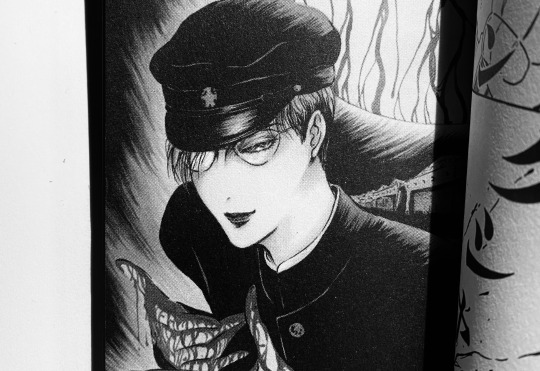
MOON AGE 15 : DAMNATION (English Translation) Moon Age 15: Damnation is a 1988 short comic by pseudonymous author Not Osada, who openly drew influence from the Tokyo Grand Guignol's work in such a way that can arguably give a loose insight to the TGG's mysteriously anomalous works. While only a slight window into what could've existed in Ameya's vision, each contemporary rendering of his world of gore-soaked medical equipment and rusted metal is valuable in what it represents. As mentioned in my prior Litchi essay, the fragments of the Tokyo Grand Guignol we have now are descendants of a cultural phantom, standing as shrouded windows to a strange intangible stage that's positioned somewhere between post-Maruo inferno, industrial subculture and decadent poetry. While Osada’s manga featured notably grizzly and cruelly morbid scenarios, his stories were made explicitly for the shoujo market with a distinctly shoujo-influenced art style. Characters appear almost doll-like with their visual perfections, all while they’re often dismantled and reassembled in bizarre surgical practices by sadistic doctors. Much like how Zera expresses horror to seeing his own imperfect organs in contrast with his youthful appearance, our pristine victims share the same internals as any other slaughtered cadaver, all in a maddening spiral of narratives that contemporary readers often described as resembling descents to insanity. This fixation of the contrast between perceived beauty and grotesqueness is arguably traced back to the Tokyo Grand Guignol’s own works, with lines accentuating the youthful features of certain characters while audience members were known to fondly look back on the actors’ appearances. Litchi himself was described as being a “cute” robot despite the violence it was programed to carry out. It’s possible that this collision is inherent to Ameya’s conceptual destruction of the TGG. A known detractor to poetic writing, he called on a romantic author to pen the screenplays to the TGG’s first three plays so he could “destroy” them in his direction. The use of beauty could arguably be a mockery of it, taking these idealized dolls and leaving them trapped in worlds of fascism and hospital rooms that are haunted by the stinging stench of antiseptics and blood. Plastic hospital drapes were used in place of stage curtains and autopsy films were shown to the wide-eyed characters, who spoke of pure blood and dirty blood, the antithesis of blood, mercuro. What is beauty a representation of in the Grand Guignol’s works with the prominent fascist leanings of the protagonists? Considering the perspectives of our characters where the Hikari Club and the deranged teachers and Nazi doctors are treated as protagonists rather than explicit antagonists, the plays could arguably be read as the decay of a self-convinced beauty under fascist rule. Songs of the pure-blooded ubermensch fading into silence as the singers all collapse, lost in their own delirium as they pump mercurochrome into their hearts and try to rationalize their own organs that resemble the internals of the so-called ‘landraces’ they rendered into lifeless meat. It’s the natural conclusion of fascism, a collapse that occurs in demented violence to the face of a denial of death. I was originally split on publicizing my translation due to copyright-related complications, but after seeing the increasing gatekeeping of TGG materials at the hands of a rapidly growing market riddled with competitive spending and scalping, I feel obliged to share it to the public who (like myself) can’t afford to spend the now literal hundreds that are required to access angura ephemera that was meant to be openly available to the public to begin with. When originally finding this story, the book it was featured in was only 5 dollars. Now it goes for 60 to 200. That's ridiculous. With all the preamble out of the way, the story is under the cut...
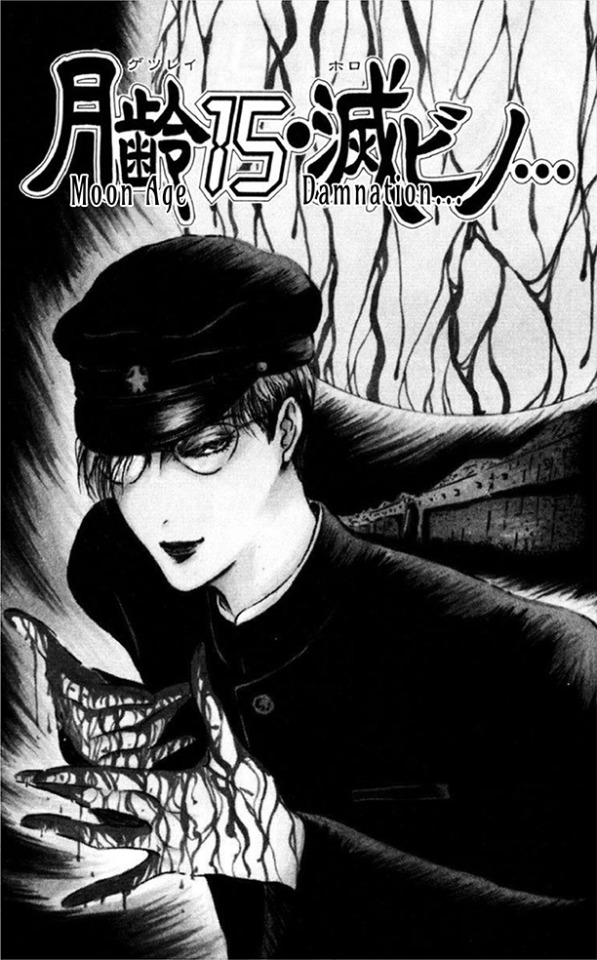
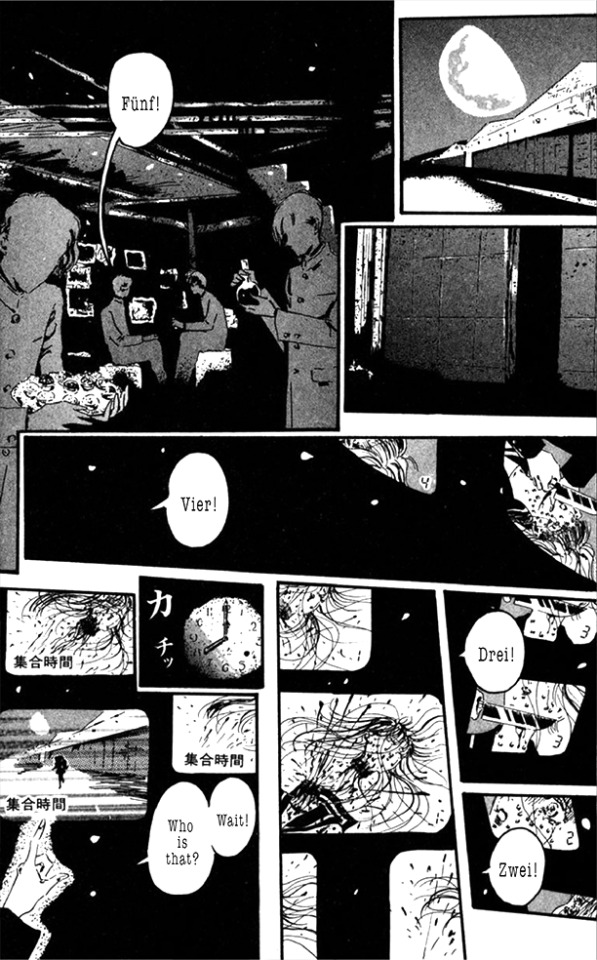
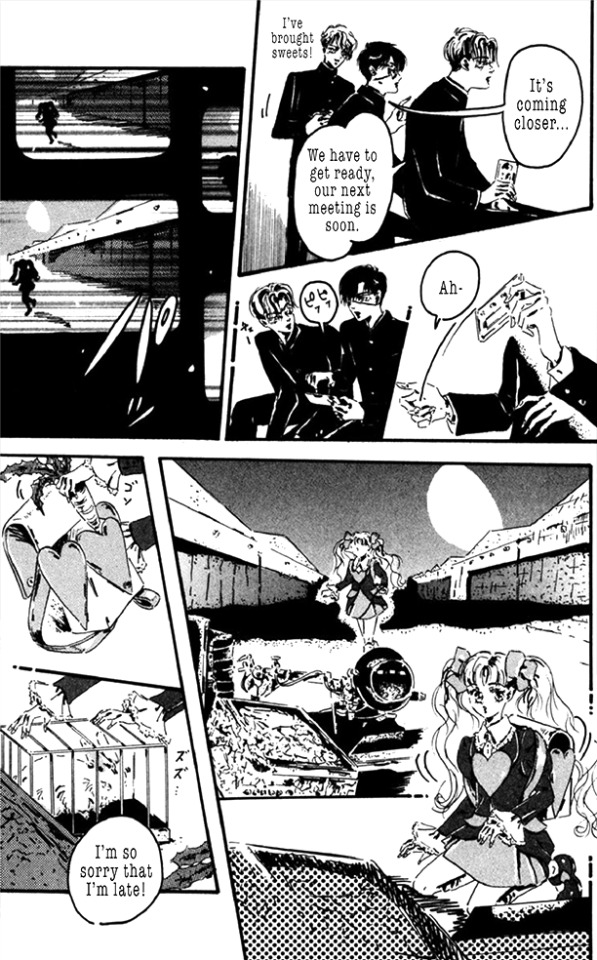
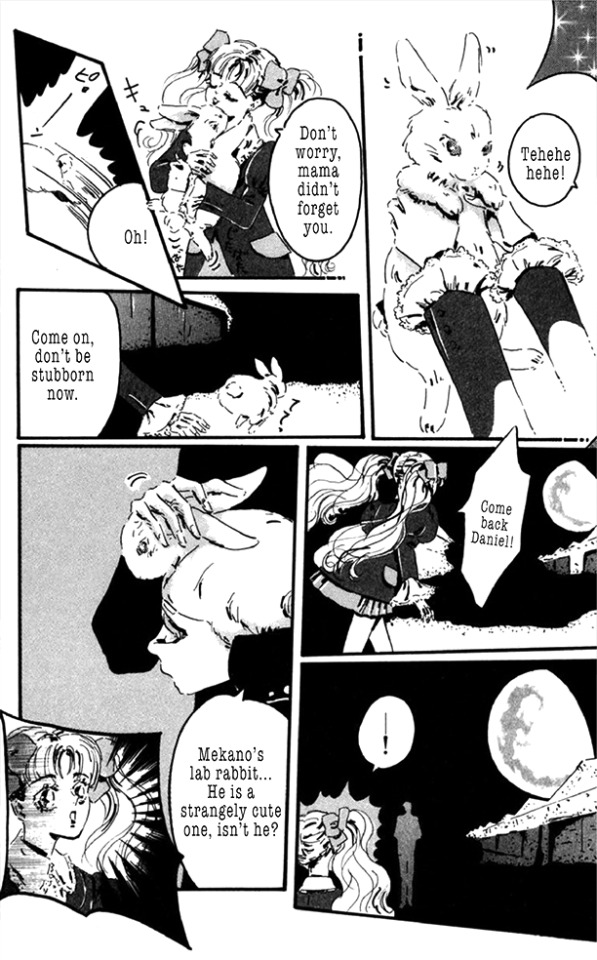
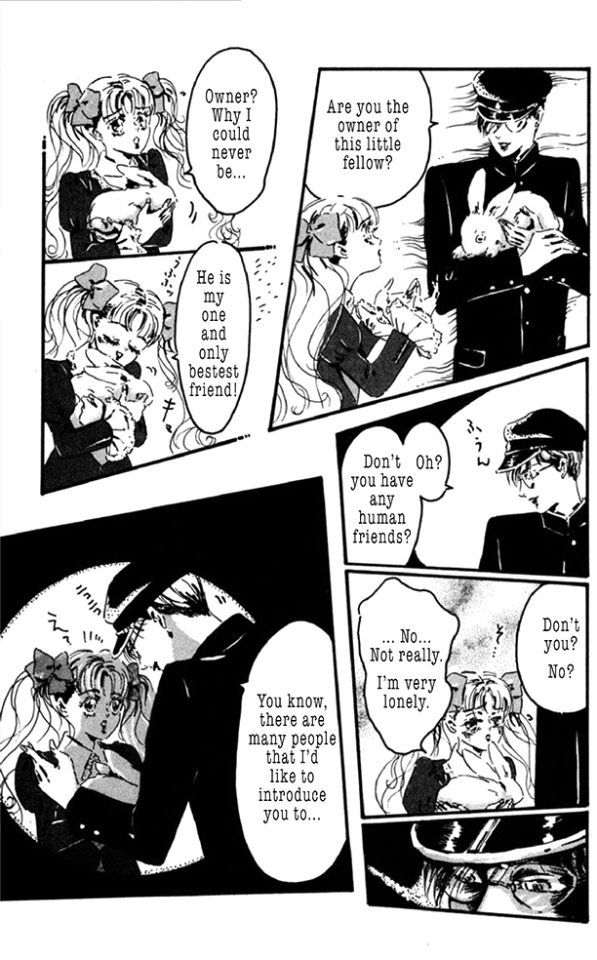
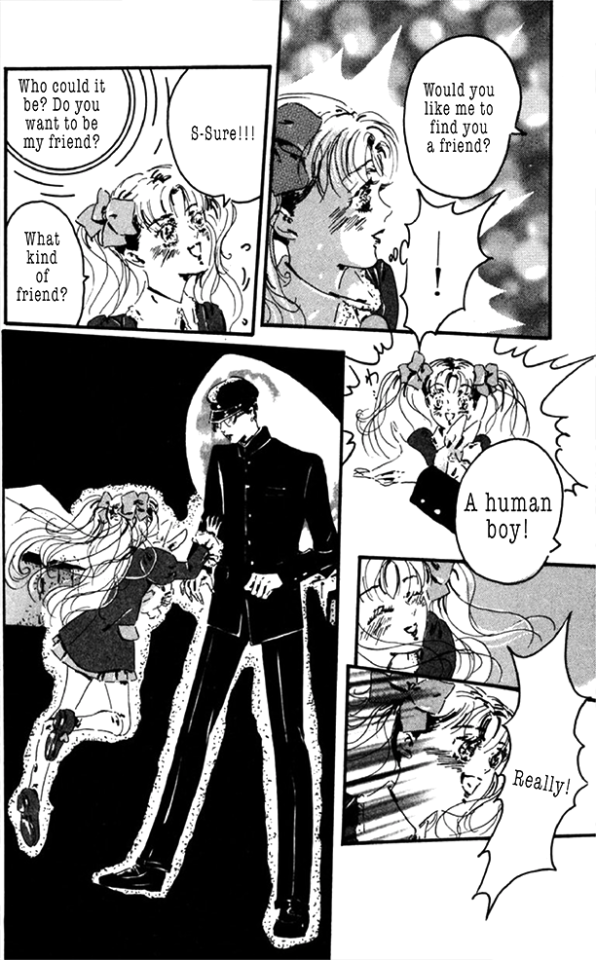
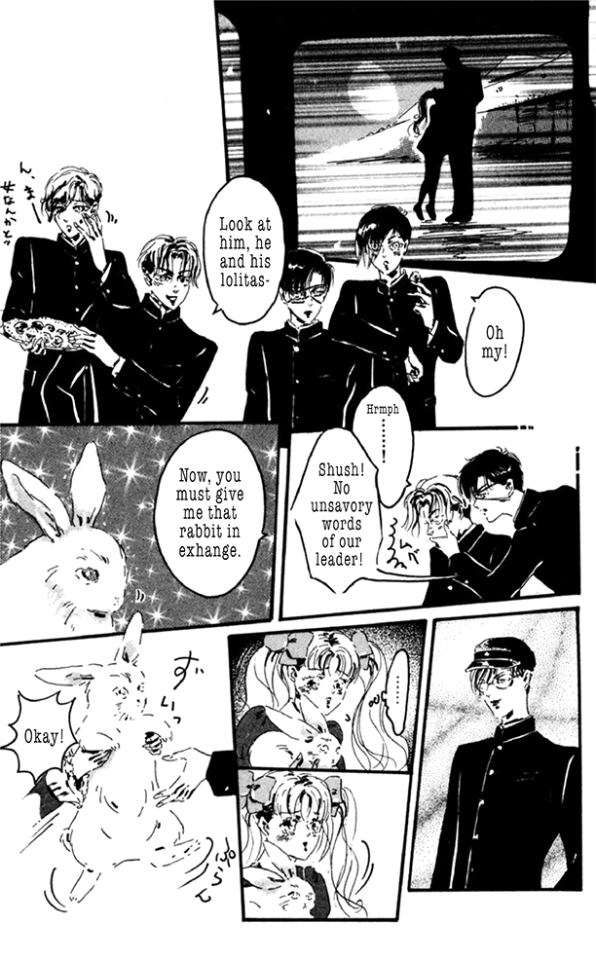
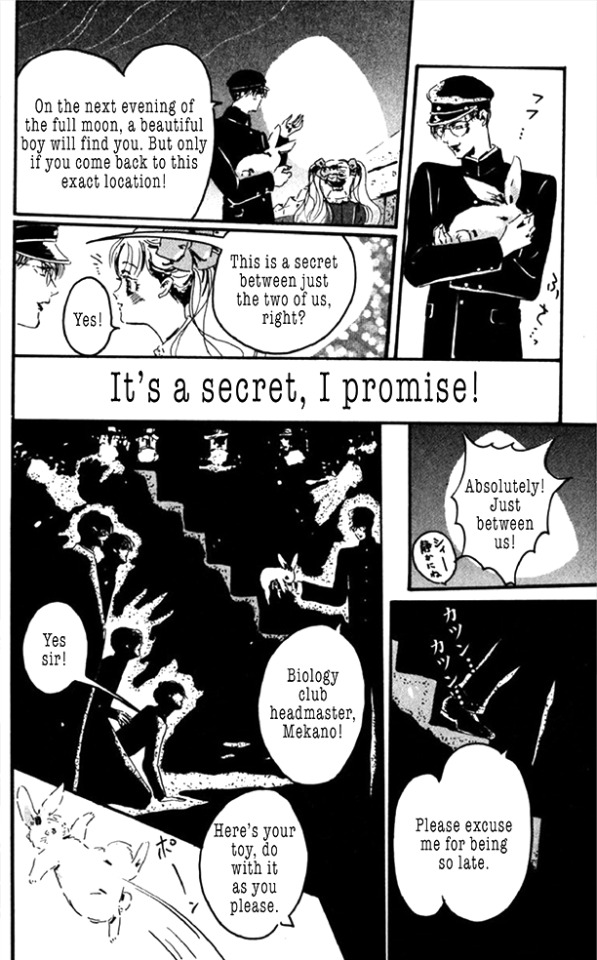
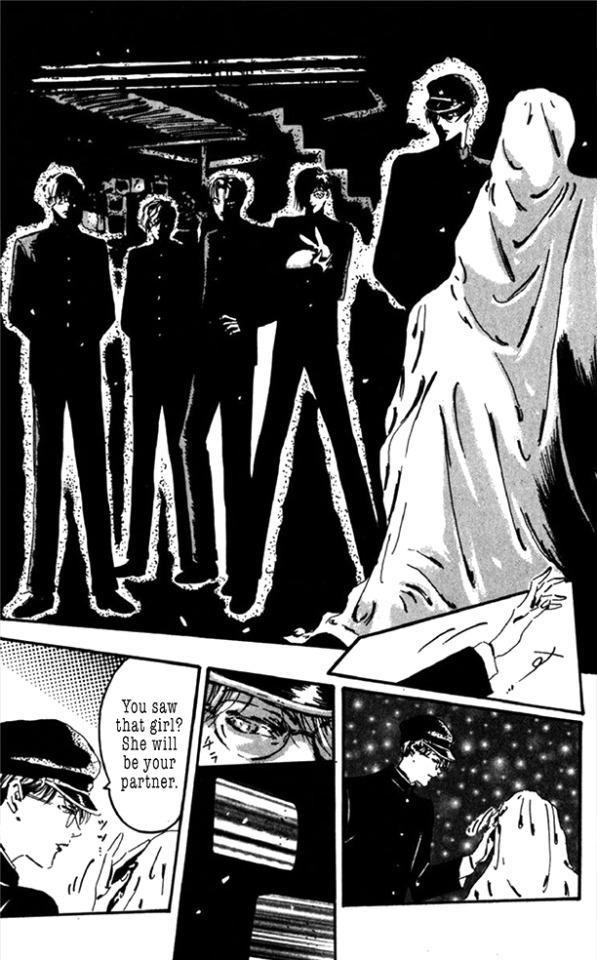
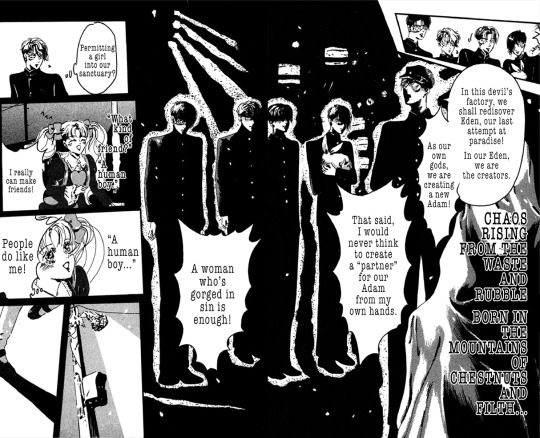
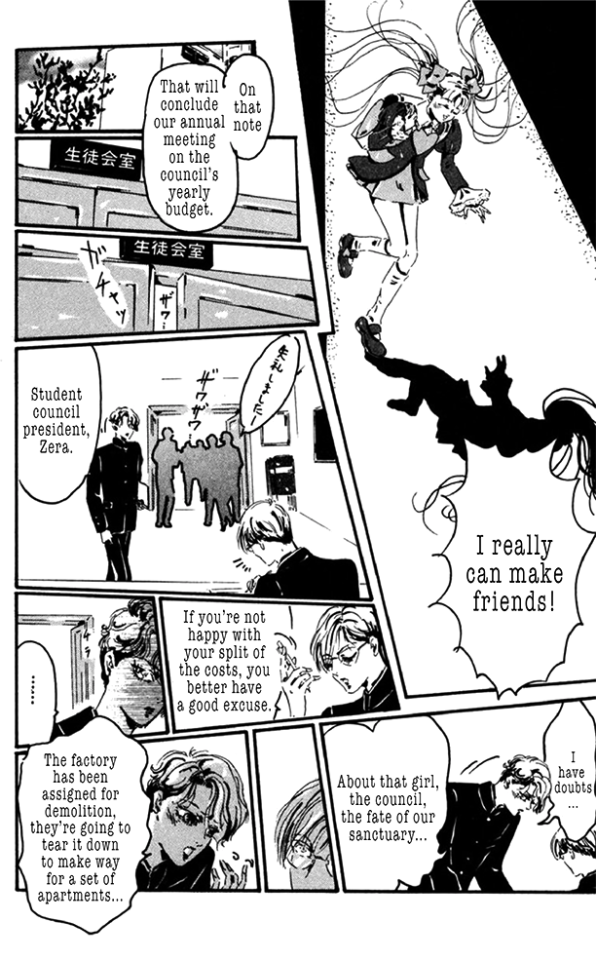

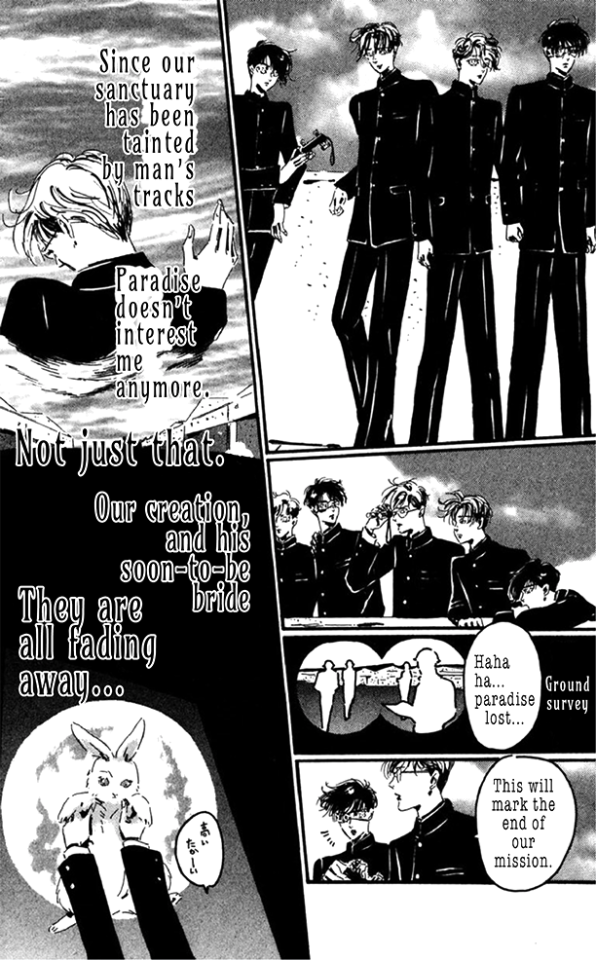
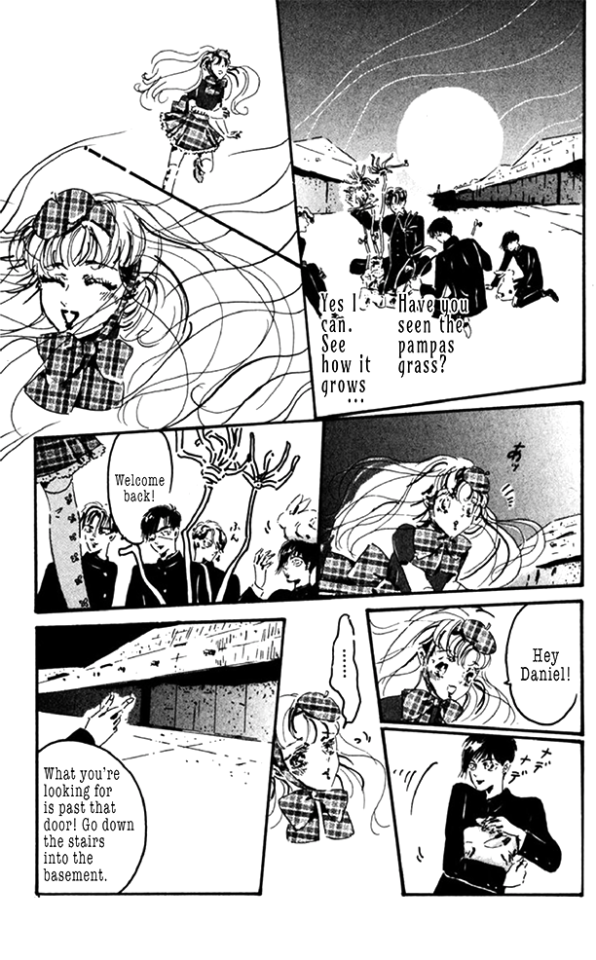
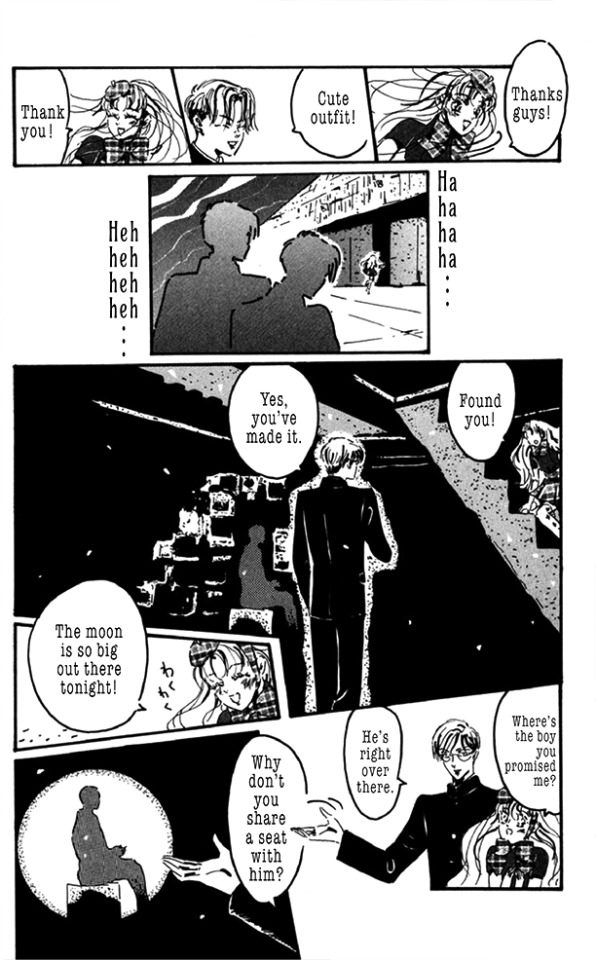
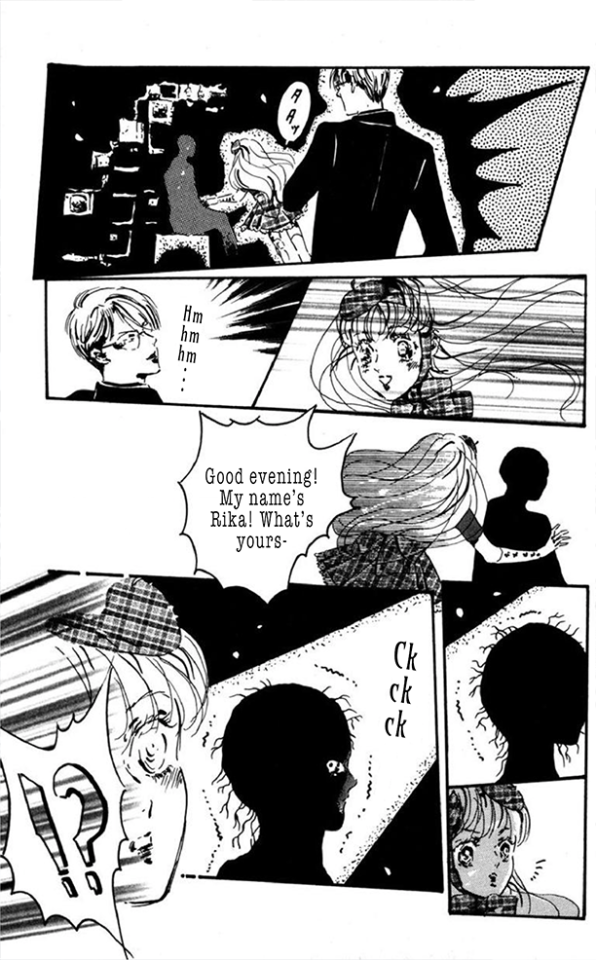
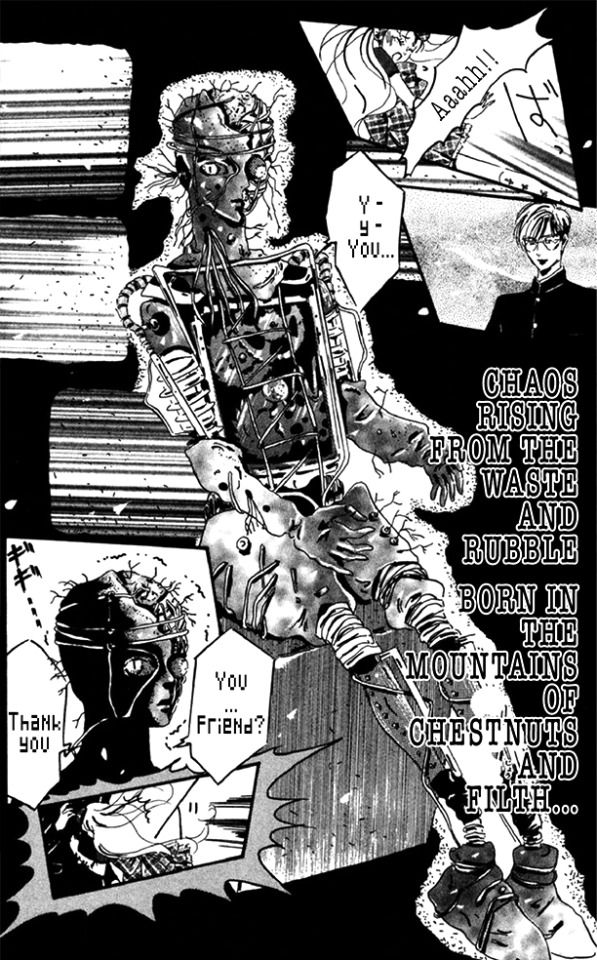
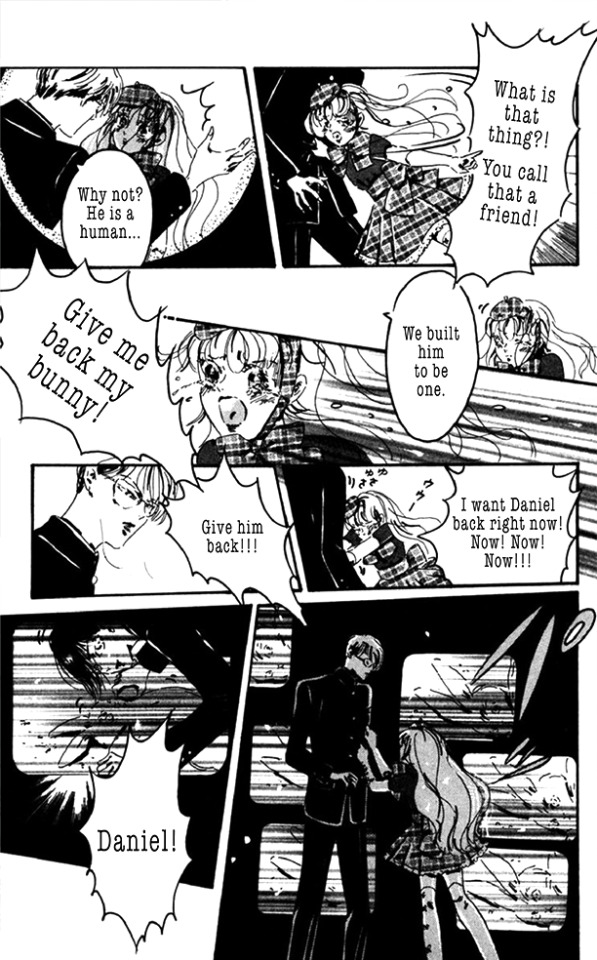
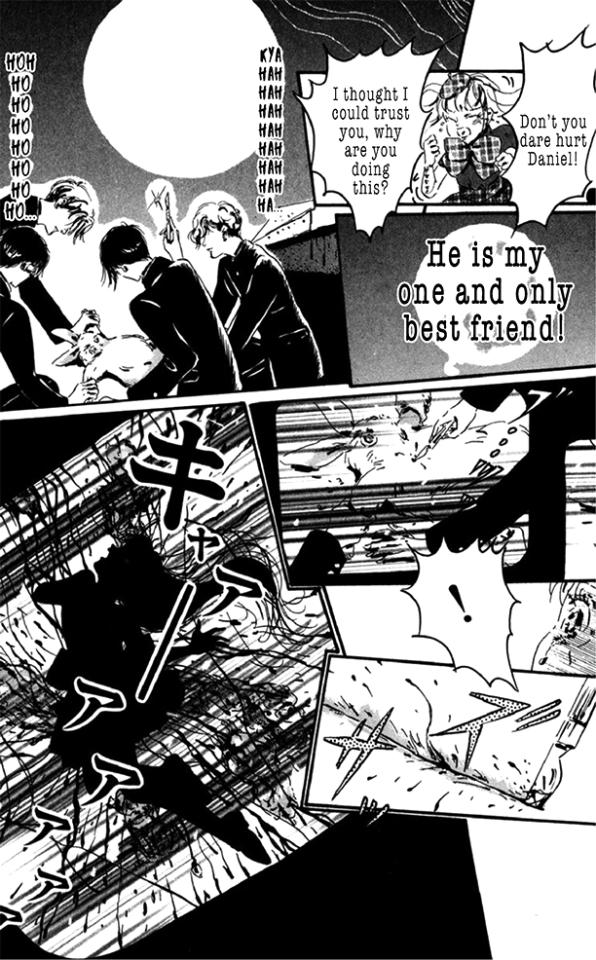
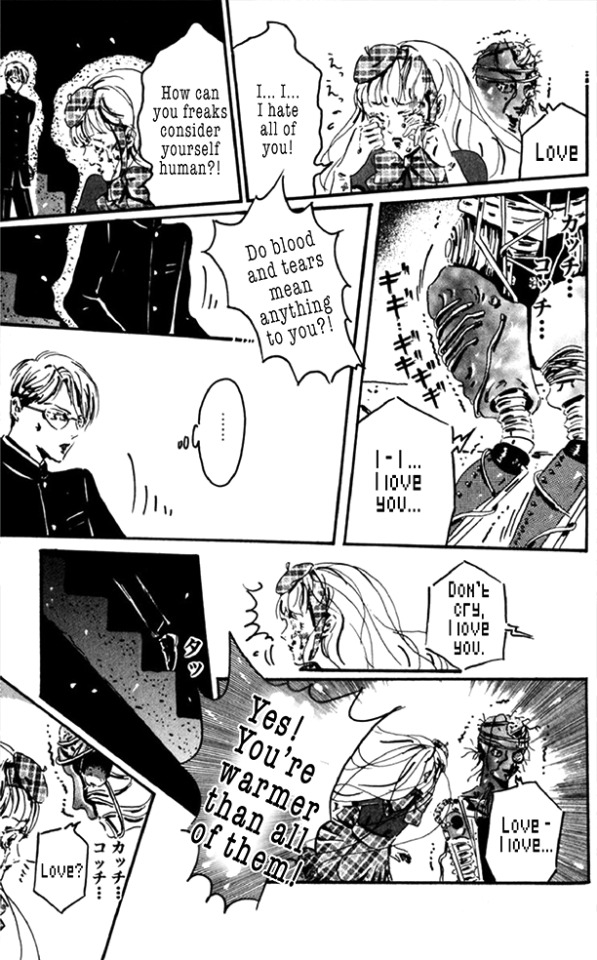
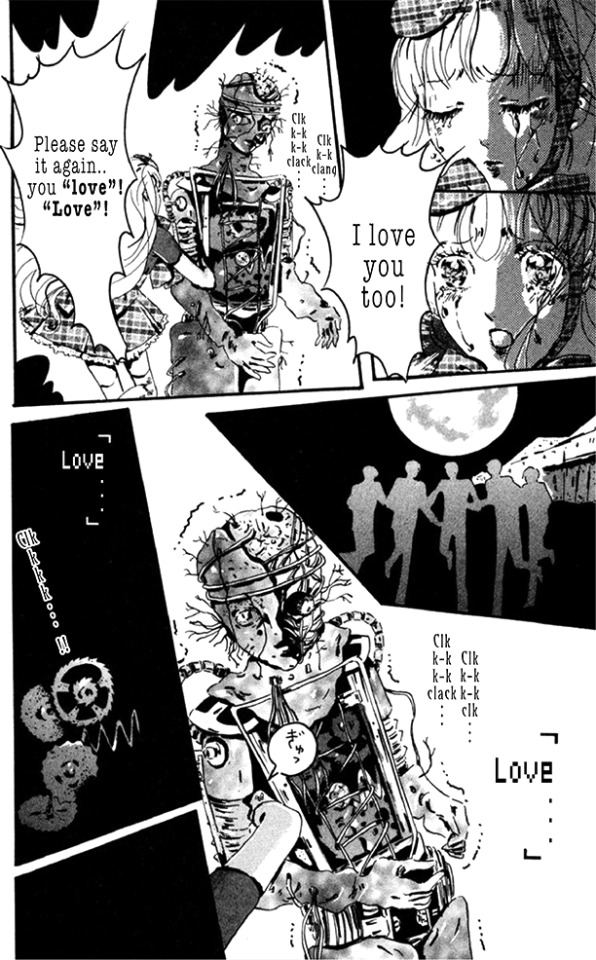
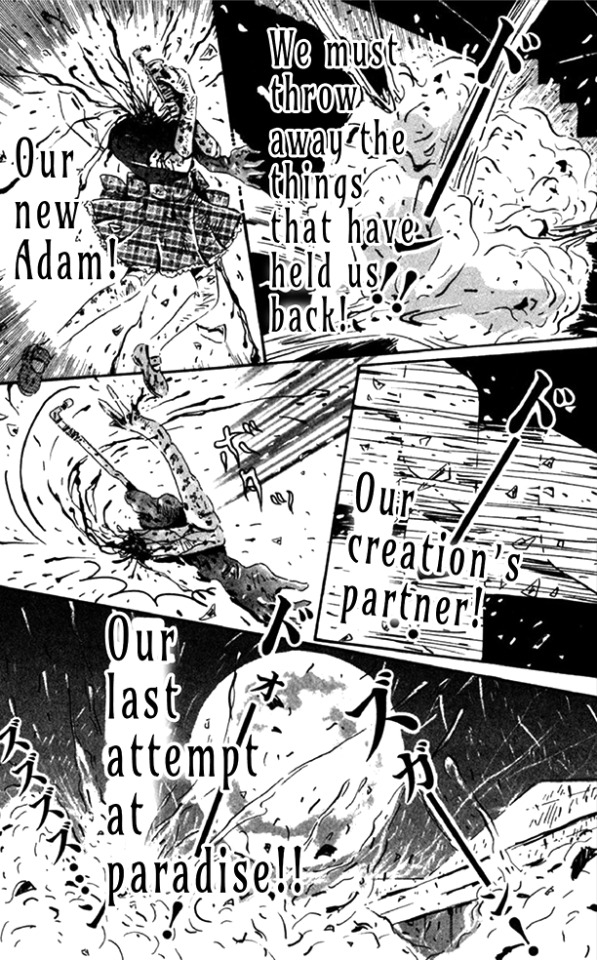
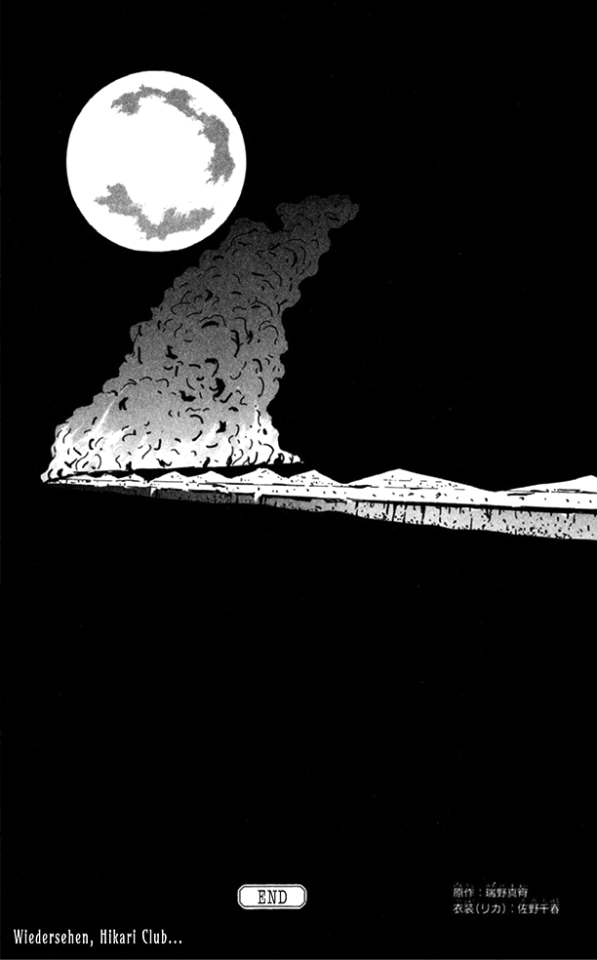
While I made my best effort to maintain accuracy to the source material in translation despite my practically nonexistent understanding of Japanese (my translation method is a Frankensteining of language learning videos, a Japanese to English dictionary from the Internet Archive and Google Translate with a lot of localizing and dissection in between), there are several details I feel I should note for the sake of transparency. One smaller one was the inclusion of the term l * lita. It was in the original text, and I was honestly very unsure of including it in my translation as it’s a term I’m personally icked out by. While I was ultimately recommended to keep the line as is for accuracy, I wish to state that it's a term I'm personally very uncomfortable with in what it represents. The other note, which is the more prominent one in the final product, are the references to The Last Attempt at Paradise. In the original text the club members solely refer to their hideout as paradise and Eden, leaving a lot of excess space in the speech bubbles after translation when making the shift from Japanese text to English. The Last Attempt at Paradise was the name of S.P.K.’s 1982 live album that documents their set at the Off the Wall Hall venue in Lawrence, Kansas. Often considered one of their best concerts and a highlight of the industrial genre, the S.P.K. Appreciation Society of Sydney in their All The Way With S.P.K. / American Tour article describes the concert as being the group's “best performance to date”, further adding that they “Flattened (an) enthusiastic audience with massive P.A. amplification of FX bass regeneration”. This insertion wasn’t done at random, as the Tokyo Grand Guignol’s works were heavily engrained in the original industrial scene of the 80s. Both the 1985 and 1986 performances of Litchi began on a playback of the S.P.K. song Culturcide (from their 1983 Dekompositiones EP), and it was likely that use of the track that led to Not Osada’s early fixation on S.P.K.’s music. At the end of Blind Beast, in a sort of reader Q&A Osada is questioned about some of his favorite music. At the top of the list he features the tracklist of the Dekompositiones EP and the track Mekano from their 1979 Mekano / Contact / Slogun single. Interestingly enough he states that he only likes those four songs from the band, following the text with laughter in regards to their remaining discography. I’m unsure if this means he was unimpressed with their noisier work (which would be curious knowing his liking of Mekano with how it originated from their earliest noise-adjacent album) or if he was directed to their later Machine Age Voodoo material and was alienated by it. In the same Q&A he also mentions the band Funeral Party, who featured specially commissioned art by Suehiro Maruo on their Dream of Embryo single. It's apparent that he also had a copy of the compilation album Vision Of The Emortion, as the list also includes C·C·Mekka and Ego'n Mole, who were both featured in the album alongside Funeral Party's only two other documented tracks, Das Sunde and Gears - Night. S.P.K. references are sprinkled throughout this story along with Osada's other Litchi-adjacent entries. Aside from one of Zera's henchmen being named after the Mekano track, it's very likely that the frequent references to Eden are in homage to the lyrics of Mekano. The first lines of the track include the verses "One by one, odd to even. Break the scenes, rudely eden...".
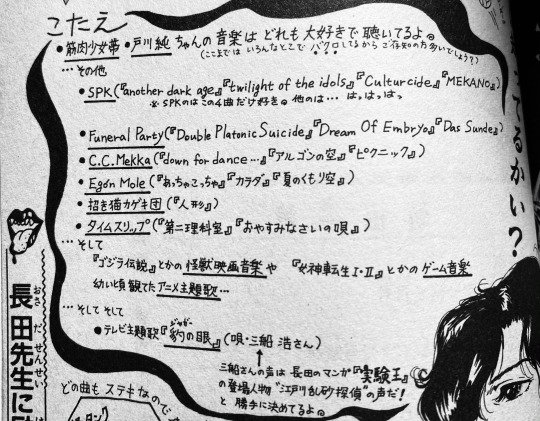
Moon Age 15 was originally printed in 1988 as a two-part miniseries in the horror magazine Complete Collection of Horror and Occult Works - HELP, namely in volumes 5 and 6. While being an early work that derived from the TGG, it still wasn’t the first comic to adapt the Litchi stage play, with Das Blut : Blood and Eternal Girl preceding it with their 1986 publication in Osada’s debut anthology Night Reading Room, sharing the same year as the TGG’s early closure following creative conflicts between Norimizu Ameya and K Tagane (the group's author, who remains anonymous to this day). It’s to be noted however that while Das Blut and Eternal Girl were the first stories to feature the Hikari Club as antagonists, they are only tangentially related with Moon Age showing more distinct Grand Guignol archetypes (musings of the full moon, examinations of the Hikari club’s misogyny, idealization of technology, and even an early rendition of the Litchi robot itself). First kept solely as a brief serial, Moon Age was later reprinted in abridged form as a short story in the 1996 Blind Beast anthology. While copies of HELP are notably hard to find and demand high prices, I was given an in depth view of both volumes that featured Moon Age’s serialization by a collector earlier last year. While the drawings are still the same on a rudimentary level, the length of the serialized version is notably longer than the later Blind Beast variant, with the HELP serialization being over 40 pages while Blind Beast’s is only 24. This was the product of the manga being entirely revised for Blind Beast’s print, with the layouts being drastically altered along with basic revisions of the line art. Certain scenes that would usually take 2 to 3 pages in the HELP version were condensed to 1, resulting in a unique tradeoff where one version feels unusually spacious in its framing while the other is heavily condensed and almost chaotic by comparison. It’s only a thing that springs on you once you compare the two variants, I saw the revised version first and originally didn’t pay any mind to it. One thing that is certain is the polishing of the art. The brush work in the Blind Beast version is refined with a more elaborate sense of weight and flow while the HELP version is notably rough with the prominent use of rudimentary screentones. It reflects as a somewhat rougher variant of the art shown in Night Reading Room. It feels strangely digital, like it’s the product of early computer art. The line-by-line reuse of the decapitation scene from Eternal Girl being shown on the TVs further adds to the strange digital feel of the art style.
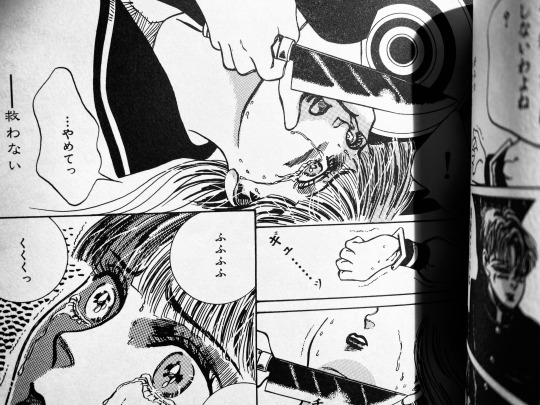

Similar to Moon Age, Osada's other stories of the Hikari Club featured the members luring girls to their brutal deaths. In Eternal Girl the members bring in a student and film her mutilation for a snuff film that acts as the story's namesake, in Das Blut they corner another student to the woods where they hang her, and in Jinta Jinta they kidnap a student who bullied one of her classmates to suicide before trepanning her with a strange device that's somewhere between an electric chair and a drill. Not Osada was very recently namedropped in the concluding essay of an English print of Kawashima Norikazu’s Her Frankenstein under the alternate Nagata Nooto anglicization of Osada’s pseudonym. Their name is a curious case as while there is a prominent written variant (長田ノオト), it’s seen numerous English iterations. In Osada’s own English signatures it is written as Not Osada (with the name apparently being derived from a German phrase), but other variants include Osada Nohto, Osada Nooto and Not Nagata. If I'm not mistaken, it could count as one of the first English acknowledgements of Osada's works in print.
69 notes
·
View notes
Text
In The Shadows / Marvel Comics OC ⌚️
Elias Drake-Thorne

— / — / —
Face Claim: Jonathan Bailey
———
Full Name: Elijah Henry Drake Thorne
Age: 26
Height: 5’11
Zodiac Sign: Virgo (reserved, analytical, and observant)
Nickname(s):
“Elias” (tends to have a softer, more modern sound compared to the traditional)
"Eli" (a casual version of his name)
"The Silent Observer" (due to his quiet and observant nature)
“Eli-Bear” (it’s what his mother used to call him)
Relationship Status: Single
— / —
Personality
Elias Drake is a figure of quiet strength and subtle complexity. His reserved nature allows him to carefully observe and analyze situations from the sidelines, stepping in only when he feels he has a complete understanding. This calm and stoic demeanor often masks a more impulsive side, revealing a slightly rash and temperamental edge when things don’t go as planned.
Despite his reserved exterior, Elias exudes a quiet confidence. He doesn’t need to be loud or overt to make an impact; when he speaks, people listen. His calm and gentle mannerism makes him approachable, yet he tends to be soft-spoken and slightly sarcastic, especially around new people. His empathetic nature allows him to offer kindness and support, though this is reserved for those he truly believes deserve it.
Reserved and Observant: Prefers to stay on the sidelines and notice details that others might miss, giving him an edge in understanding complex situations.
Quietly Confident: Makes a strong impression without needing to be overtly loud; his thoughtful insights and calm presence often capture attention.
Independent but Collaborative: Enjoys working alone but understands the importance of teamwork and collaboration when necessary, balancing solitude with cooperation.
Slightly Rash: Although generally measured, he can act impulsively when his temper flares or when faced with significant challenges to his principles.
Kind but Selective: His kindness is genuine but selective, extended to those who earn his trust and respect. He is gentle and supportive but discerning about who receives his warmth.
Protective and Loyal: His loyalty is unwavering for those he cares about deeply. Elias’s protective instincts ensure that he stands by and defends his loved ones, even if he seems distant to others.
—
Quirks and Interests:
Wears Glasses: His glasses add a thoughtful and intellectual touch to his appearance.
Bookworm: Though he enjoys reading, he has a stronger passion for films and often uses them as an escape.
Slight Temper: He tries to keep it in check but can be a bit hot-headed when frustrated.
———
—Background 🗞️
Elias Drake-Thorne grew up in a gritty, crime-ridden neighborhood of New York City, an environment where survival demanded caution and sharp instincts. His family lived on the fringes of society, often struggling to make ends meet, but they instilled in Elias the importance of resilience and intelligence. The loss of his parents instilled a deep desire for justice, but unlike the flashy superheroes he saw on the news, Elias preferred to operate in the shadows.
His quiet and observant nature helped him navigate the dangers of the streets, but it also set him apart from others his age, who often resorted to louder, more aggressive means of coping.
Struggles in School:
Academically, Elias was never the best student. He found it hard to focus on traditional subjects that didn’t capture his interest. However, when it came to technology, engineering, and creative writing, he thrived. Teachers often noted that while Elias lacked discipline in some areas, he excelled when left to explore topics on his own terms.
He was the kind of student who would rather figure things out through hands-on experience than by reading textbooks. His self-directed learning led him to develop a keen understanding of technology and electronics, often repairing gadgets or inventing small devices for fun.
— | — | —
Career at Stark Industries:
Eventually, Elias’s natural talent with technology earned him a spot at Stark Industries as a tech consultant. Despite his unconventional academic background, his skill set made him an asset to the company. Elias was particularly valued for his ability to think outside the box, offering creative solutions to complex problems.
While he kept a low profile, preferring not to attract attention, he found satisfaction in contributing to projects that supported the Avengers and enhanced Stark’s technology. His job allowed him to quietly play a part in protecting the world, even if he was never on the front lines.
Passion for Writing:
Though technology became his career, Elias’s true love has always been storytelling. He developed a passion for writing early on, finding solace in crafting narratives that explored justice, corruption, and the complexities of human nature. In his free time, he began writing investigative pieces, focusing on the darker, hidden parts of New York’s criminal underworld.
His reserved nature made him an excellent investigator—people rarely noticed him, and he was adept at blending into the background. His articles, though often published anonymously or under pseudonyms, became a way for him to expose the truths others were too afraid to confront.
————

—|—|—
—Likes ☕️
Iced Coffee: Elias has a penchant for iced coffee, which keeps him alert during long nights of work or writing.
Drama Shows: He enjoys drama shows, particularly those with complex characters and intricate plots. He finds them a great escape and a source of inspiration for his own writing.
Mac & Cheese: A comfort food that reminds him of simpler times; he often makes it for himself when he’s feeling nostalgic or in need of a quick meal.
Simple Fashion: Prefers understated, practical clothing—jeans, simple tees, and comfortable shoes. He values functionality over fashion trends.
Homebody: Elias enjoys staying in and tends to be a homebody. He finds solace in the comfort of his own space, away from the chaos of the outside world.
—Dislikes 📌
Loud, Crowded Places: Due to his reserved nature, Elias dislikes loud, crowded environments which can be overwhelming and stressful for him.
Disorganization: He values order and tends to be irked by disorganization, whether in his personal space or in his work environment.
Unnecessary Attention: Prefers to stay out of the spotlight and avoids situations where he is the center of attention.
Overly Sweet Foods: While he likes mac & cheese, he’s not a fan of overly sweet foods or drinks, finding them cloying and unappealing.
—Nerdy Interests 📼
Films and Series: Elias is a film enthusiast who enjoys everything from classic cinema to modern blockbusters. He often analyzes films and series for their storytelling techniques and thematic depth.
Video Essays: He enjoys watching video essays on a variety of topics, including film theory, technology, and social issues. They provide him with new perspectives and insights.
Music: Music is a big part of his life, and he has a diverse taste ranging from classical to modern genres. He often listens to music while working or relaxing at home.
Tech Gadgets: Beyond his professional work, Elias has a deep interest in the latest tech gadgets and innovations. He enjoys keeping up with the latest advancements and understanding how they work.
Comics and Graphic Novels: While not a superhero himself, Elias enjoys comics and graphic novels for their storytelling and artistic value. They provide him with creative inspiration and a way to unwind.
— | — | —
—Elias Drake-Thorne's Soundtrack Playlist 🎧
“Sweater Weather” – The Neighbourhood
Perfect for Elias’s cozy, laid-back, and home-centered vibe. It’s atmospheric and moody, reflecting both his introverted nature and subtle complexity.
“Sure Thing” – Miguel
This track brings out Elias’s grounded, nurturing side. It has a sensual yet chill vibe, showing his capacity for caring deeply and being there for those he holds close.
“Saturn” – Sleeping At Last
A beautiful, introspective track that mirrors his thoughtful, reflective nature. It hints at his connection to loss, his desire for justice, and his emotional depth.
“Leave The Light On” – Tom Walker
A perfect fit for the more intense, emotional side of Elias, where he wrestles with personal struggles. The song’s message about holding on through tough times connects to his quiet but strong resilience.
“I’ll Be Good” – Jaymes Young
This song matches Elias’s inner conflict, balancing his quiet demeanor with a desire to do better and strive for justice, even in his more discreet ways.
“Flares” – The Script
An emotional, heartfelt track that speaks to Elias’s experience with loss and his gentle side. It captures his vulnerability and the quiet strength he draws from those experiences.
—— / —— / ——

— | —
—Style & Background Insights 🔓
~Style
Casual and Practical: Elias's style is understated and practical. He favors simple fashion choices—think well-fitted jeans, casual shirts, and comfortable sweaters. His look reflects a preference for practicality and comfort over flashy trends.
Subtle Elegance: His wardrobe includes pieces that are stylish yet subtle, with a preference for muted colors and clean lines. This aligns with his reserved personality, emphasizing functionality and a low-key elegance.
Tech-Influenced Accessories: Given his tech-savvy nature, Elias often wears minimalist tech accessories, such as smartwatches or sleek glasses, which complement his practical and intellectual style.
~Background
Challenging Upbringing: Growing up in a tough, crime-ridden neighborhood in New York, Elias witnessed the harsh realities of life early on, despite trying to see the light in the darkness. This environment shaped his cautious and observant nature, instilling in him a deep-seated desire for justice and a resolve to make a difference in his own way.
Dual Career: Balancing a career in tech consulting with a passion for journalism, Elias has forged a path that reflects his diverse interests and skills. His work at Stark Industries showcases his technical prowess, while his journalism endeavors highlight his creative and communicative side.
Quiet Heroism: Elias’s approach to justice and heroism is understated. He works behind the scenes, tackling issues with a subtle, yet effective impact. His focus is on creating change quietly and meaningfully, rather than seeking the spotlight or overt recognition.
Homebody Nature: Preferring a quiet life at home, Elias finds solace in simple pleasures—like enjoying a cup of iced coffee, indulging in drama shows, or spending time with his favorite books and films. His home is a sanctuary where he can unwind and recharge, away from the demands of his professional life.
— / — / —
—The Soft-Spoken Journalist 🖥️
Elias Drake-Thorne, much like a male counterpart to the iconic Lois Lane, embodies a blend of strength, determination, intelligence, and kindness. His journey reflects a deep commitment to storytelling and a passion for uncovering the truth, making his transition from tech consultant to journalist a natural evolution of his career and interests.
~Career Transition
Shift to Journalism: Elias's career initially centered around tech consulting at Stark Industries, where his technical expertise was invaluable. However, his true passion has always been storytelling. Recognizing that his heart lies in writing and reporting, Elias has made a deliberate shift towards journalism, focusing more on his love for writing and storytelling.
Focus Areas -> Elias's new role allows him to explore a range of topics:
- Entertainment and Celebrities: He writes engaging stories about the entertainment industry and celebrities, providing fresh perspectives and in-depth coverage.
- Technology: Combining his tech background with his journalistic pursuits, Elias covers the latest trends and innovations, offering insights that bridge his technical knowledge with his storytelling skills.
- Real-Life Events: His investigative work delves into significant real-life events, uncovering hidden truths and presenting them in a compelling manner.
- Lifestyle: Elias also explores lifestyle topics, sharing stories that resonate with his audience and reflect his understanding of contemporary issues and interests.
- Passion for Truth and Impact: Elias is driven by a desire to make a difference through his work. His stories aim to inform, inspire, and impact readers, emphasizing authenticity and the search for truth.
-> Narrative Style
- Thoughtful and Insightful: Elias's writing is characterized by its thoughtfulness and depth. He brings a nuanced perspective to his subjects, combining detailed analysis with engaging narrative techniques.
- Empathetic and Relatable: His approach to journalism is empathetic, focusing on the human element behind the stories. Elias’s kindness and sensitivity enable him to connect with his subjects and readers on a personal level.
- Commitment to Authenticity: Elias prioritizes honesty and integrity in his reporting. His commitment to presenting accurate and meaningful content reflects his dedication to making a positive impact through his work.
— / — / —

— | — | —
—Fun Facts 🖇️
— Multilingual Skills: Elias is fluent in both English and Spanish, a skill he picked up growing up in a multicultural neighborhood. He enjoys using his language skills to read international literature and connect with a diverse range of people.
— Phobia of Public Speaking: Despite his career in journalism, Elias has a deep-seated fear of public speaking. He prefers written communication and finds large audiences daunting, often opting for written articles over speaking engagements.
— Collector of Vintage Cameras: Elias has a growing collection of vintage cameras. His fascination with photography extends to collecting old and rare models, each with its own unique story and history.
— Night Owl: Though he often forces himself to adhere to a morning routine due to work demands, Elias is naturally a night owl. He finds that his creativity and productivity peak during the late hours, which is when he does most of his writing and thinking.
— Unusual Hobby: Elias is a bit of a “house husband” at heart. He takes pride in keeping his living space organized and enjoys the routine of household chores, finding them oddly therapeutic.
— Pet Peeve: He’s easily annoyed by loud or chaotic environments, preferring quieter, more serene settings where he can concentrate and feel at ease.
— Dream Destination: Elias dreams of visiting Paris, France someday, drawn by its rich cultural history, iconic landmarks, and vibrant arts scene. He’s eager to explore its museums, architecture, and culinary delights.
———
And we’re done! Pls let me know what you think 💭
Remember to like, comment and share
Tags: @gaminggirlsstuff @gcthvile @missstrawbs2001 @djs8891 @starkleila @cherrysft @mandylove1000 @yetanotherwells @rickb-chaos @topgun-imagines @hardballoonlove @buckysteveloki-me @sherloquestea @ximehs @savemewattpad @lazywolfwiccan @terry-perry @triptuckers @daughter-of-melpomene @superspookyjanelle
#marvel comics oc#mcu rp#my ocs#oc x canon#iron man oc#iron man fanfiction#mcu ocs#inspired by lois lane#journalism#jonathan bailey#oc intro#oc introduction#orginal character#mcu oc#nerd oc#stark industries#spiderman original character#male original character#mcu x canon#inspired by dc comics#clark kent aesthetic#reporter oc#the daily bugle#anthony bridgerton
37 notes
·
View notes
Text
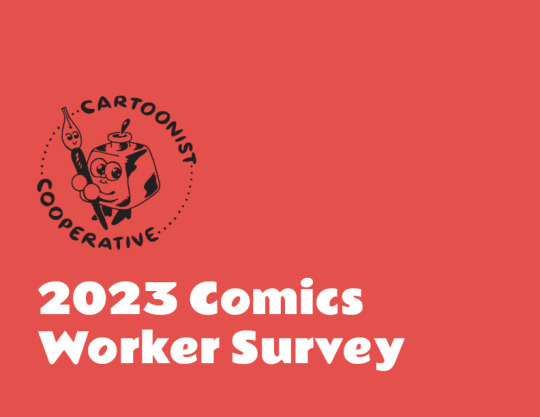
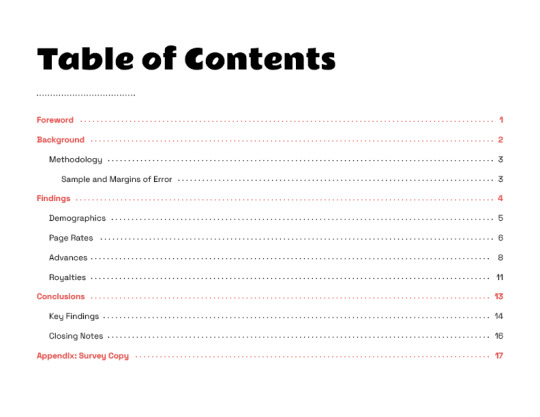
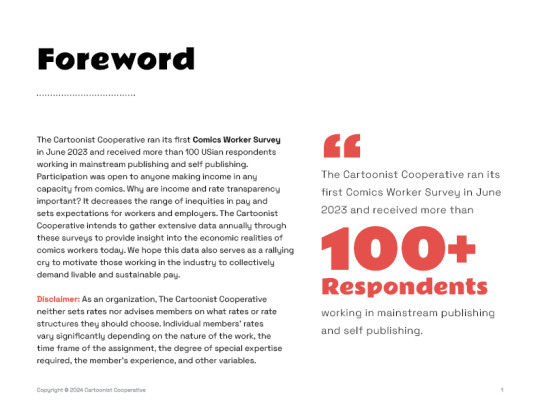

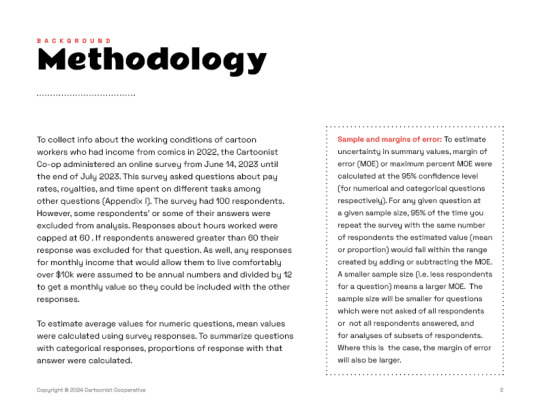





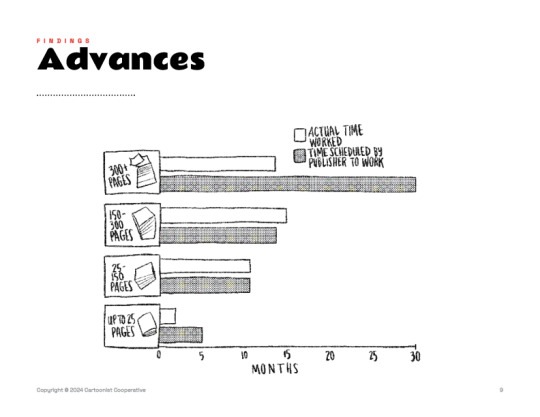
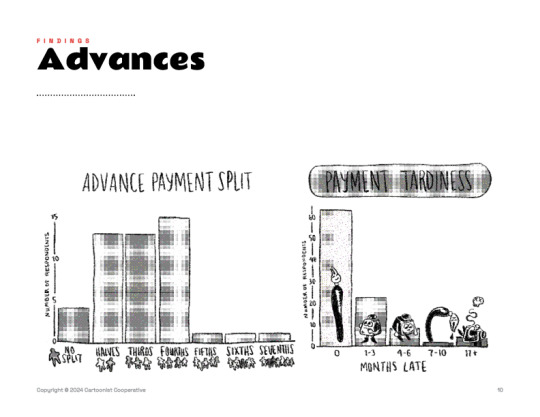

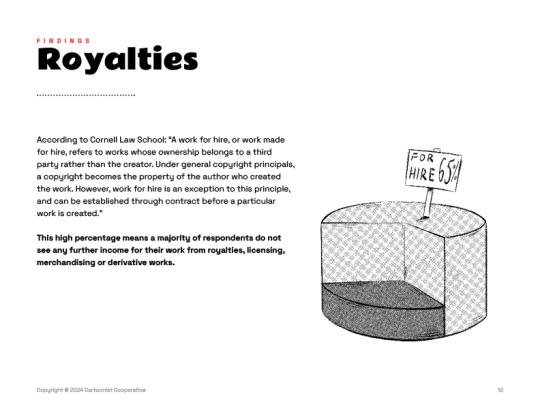

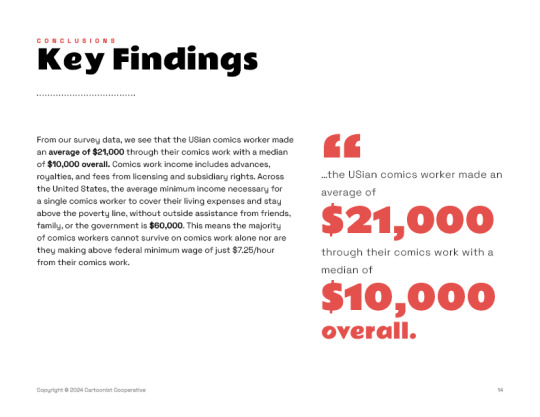





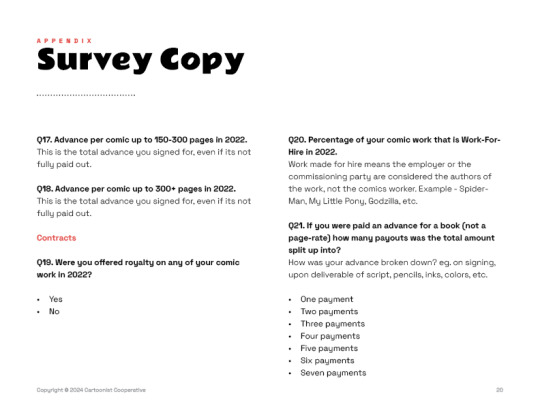

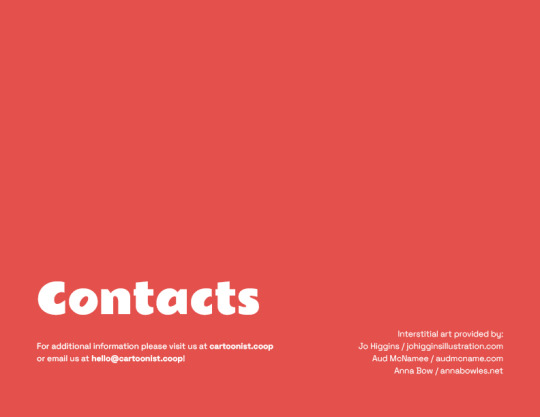
The Cartoonist Cooperative ran its first Comics Worker Survey in June 2023 and received more than 100 USian respondents working in mainstream publishing and self publishing. Participation was open to anyone making income in any capacity from comics. Why are income and rate transparency important? It decreases the range of inequities in pay and sets expectations for workers and employers. The Cartoonist Cooperative intends to gather extensive data annually through these surveys to provide insight into the economic realities of comics workers today. We hope this data also serves as a rallying cry to motivate those working in the industry to collectively demand livable and sustainable pay.
You can also find this information on our journal here: https://cartoonist.coop/journal/the-2023-comics-worker-survey/
Stay tuned for a presentation/open house stream later this month!
73 notes
·
View notes
Text
i'm finding it so surprising that no one (yes including me) hasn't really done any exploration into pavitr's village life. it's in his (comic) lore, it's where his story is first started out, and lowkey it never gets talked about, neither by the audience nor marvel. we're gonna change that >:)
no but i completely understand why we as the audience mightn't've delved into this route before. most of us online folk don't have *that* much experience working on the land. i'm not judging anyone for it, it's just something i've noted. on that note i'm pointing fingers at marvel themselves for brushing over such an important facet of the character- he's got all the hallmarks of regular peter parker spider-man, but where peter's stories oft highlight his origins and the different experiences he has as someone from the suburbs, the same isn't done for pavitr!! there are no flashbacks to his time as a village boy after he moves into mumbai!!! there is no discussion regarding any experience in his youth!!! (there is exactly only 1 flashback in 2023's SMI #5 and it is only 6 panels long talking about helping those in need). that whole portion of his life is just NOT THERE and i can't keep living life like this.
truth be told the only reason i'm even making this post at all is because i got a little too inspired by the stories my parents have told me. we've got tales of parents disobeying their parents and playing out in the streets 'til nightfall and all that. but hearing my parents talking about the joy they've managed to find between hours of tending the crops, going to school, catching the buses, avoiding spooky marshes and abandoned houses, catching rainwater and racing paper boats, making sculptures out of clay and twine, catching fish in the wells and butterflies between bushes, being present in communities and village gatherings...there is so much more to life than we realise.
i'm genuinely not talking about cottagecore aesthetics when i say i think working on the land might've healed something in me. sure a bunch of the things that i do now might definitely be squandered, but different parts of me *could* have flourished if i was tilling and such. many of the core parts of me would've remained, but i'd probably be putting my energy in a bunch of other things (like tilling and such, obviously. and then crying over harvests). the second-generation immigrants yearn for the fields (it's me, i'm the second-generation immigrant).
FURTHERMORE (with uppercase and in bold, that's when you know i'm being serious) if i were to take a more sociopolitical look at things, i think pavitr being personally connected to the land in some way, shape or form can actually provide insight into the livelihoods of modern agriculture and the farming industry. obviously centred on desi farming practices, but also on the global scale, if that can be allowed. he can shed light on a bunch of issues!!! he can fight for the rights of farmers, of those who tend to the land, and the members of the community!!!!
i don't know! i don't know. i just think spider-man india can provide a beautiful avenue to explore and appreciate the livelihoods of farmers and rural and/or indigenous communities. he can also highlight societal issues working against them and shed light on ways we can better everyone's circumstances while preserving these unique experiences and cultural practices. i don't know. i just think it's neat.
pavitr prabhakar, if only marvel would let me into spidey hq i'd do you SO MANY FAVOURS i'd bring in a new age of spidey india comics fr fr i'd also blast nick lowe into the sun so in fact spider man would be free forever from stupid idiots
#pavitr prabhakar#spider man india#atsv#atsv pavitr#spider man#desi culture#desi agriculture#agriculture#im using desi very broadly bc i want to be able to capture ALL of these collective experiences like they should all be recognised#agnirambles#i just know there will be people who will skip over this bc i didn't make a whimsical silly pavitr post and instead i'm talking about farms#i'm giving a chance for the boy to breathe and speak for the collective desi experience!! he's a vehicle for ideas!!! don't hound him!!!!#all i ask is for your thoughts and considerations on this post... that is all 🥺
19 notes
·
View notes
Text
✨HOOVESANDFLOORPAWS' TAGLIST

Do Not Reblog, please. It’s continuously under construction ⚙️ 🔞 This blog is 18+
⏱ if you want to look at a tag in the order old to new, add /chrono to the end of the tag link! (in-browser only)
Larry 🏠⚓️💙💚 main tag for everything Harry&Louis Masterpost • masterposts & compilations Timelines • timeline compilations Meta • insights/explanations/analysis Complete Larry Tattoo Timeline • w/ pictures & meta (last update: Feb '25) H&L Companies Masterpost • deep dive into all 19 companies Harry & Louis were/are in during and after 1D (last update: Feb '25) [coming soon] Elongated For Archive Purposes • old important masterposts, etc. that were previously under a Read More (which get deleted when the blog deletes). (I only started doing this in Nov '24, so there's quite a lot more to come.) Do Not Lose • extra important posts
For New Larries
2010 / 2011 / 2012 / 2013 / 2014 / 2015 / 2016 / 2017 / 2018 / 2019 / 2020 / 2021 / 2022 / 2023 / 2024 / 2025 • i only started in Oct ‘24 to use the years in my tagging system, so bear with me while I go through almost 600 pages of this blog and slowly add them
Baby Boyfriends • est. 2010 Future Husbands • mostly pre-Sep-2013 (still need to tidy this tag up) They Are Married • mostly post-2013 (clarification: i don’t believe they are legally married in the UK, yet, but that they’ve been engaged since 2013 and are practically married) I Love Their Love • domestic bliss Pick Someone Who's Supportive Rainbows • 🏳️🌈 everything sexuality-related Coming Out • Closeting Larry Tweets • Always in my heart, Harry Styles, yours sincerely, Louis Receipts • Harry&Louis-centered Lyrics • *what does it mean what does it ALL MEAN.gif* Tattoos Signals • Touches • Lyric Changes Sharing Clothes • Coded Clothing Harry Wants A Baby & Louis Wants A Baby / The Larents RBB and SBB • 🧸🏳️🌈🧸 Harry's Rings ⚓️ Media: Video • Live • Interview • Audio • Unreleased Songs Manip • Artwork • Comic • AU GIFset • Edit Fic Rec Download • videos, fics, etc. Music Video • Crack / FIMQ X-Factor • Wellington 🥔 • 1D Day Dunkirk • My Policeman ⚓️ Misc: Ask Paz Rambles • posts including my thoughts Mine • my posts LMAO • posts to chuckle & snortlaugh about Cute Things • Larry-themed, for when you need a Pick Me Up :') NSFW • Cock Talk • Butt Business • 🍌🍑 Fond Frog Laser Stare • it's a Harry-thing 🐸😌 Music Industry In This House WE HATE SYCO Pleasing • 28 Clothing ⚓️ People: Harry • Louis • Liam • Niall • Zayn • Anne • Jay One Direction The Tomlinsons • all things Tomlinson-Styles family Louis' sisters & Harry's sister all have their own tag, as well. just click on my The Tomlinsons tag and when posts with them pop up, click on their respective tag ⚓️ Old tags & stuff: Power Sigh You Can’t Make This Shit Up Zayn Left Housekeeping • general info on the blog ⚓️ Beards, Stunts & other bullshit Babygate • Holivia • Haylor • ElouNO • Stunts
14 notes
·
View notes
Text
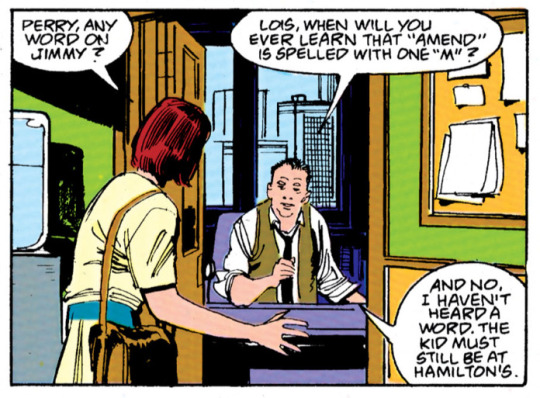
The early days of Lois’ spelling difficulties/dyslexia.
A semi-prominent characterization of Lois Lane today is her difficulty spelling. There were sparks of it in 1940 radio show—though not as a character trait and more as an occasional plot device (examples below). In the mid 90s, it began to take root in the ways we actually see it today. The first appearance I noticed is the above in The Adventures of Superman #458 from 1989 and written by George Pérez (plot) & Dan Jurgens (words & pencils). It doesn’t become a particularly common trope immediately after that, but it very slowly catches on. It’s most often used in scenes to show the humanity, flaws, and mundanity of her work in the Planet.
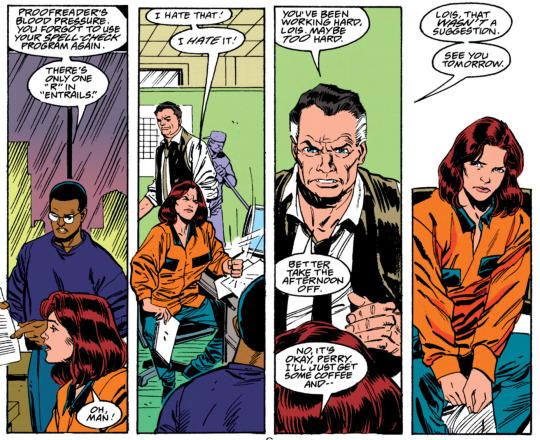
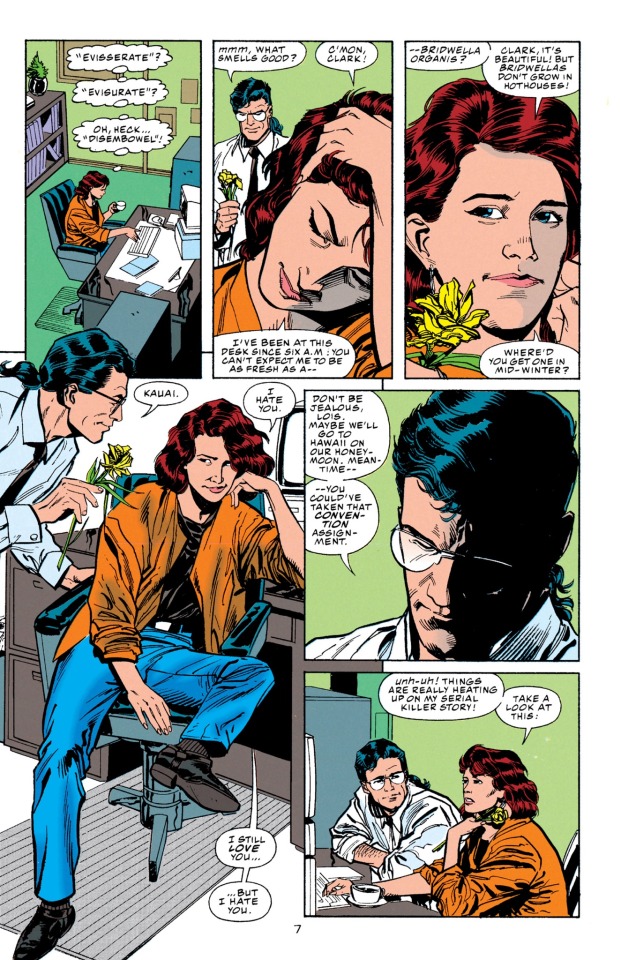
Action Comics #704 and #708 by David Michelinie (writer), Jackson Guice (pencils), Denis Rodier (inks), Albert De Guzman & Bill Oakley (letters) and Glenn Whitmore (colours)
The spelling difficulties are use to humanize her, but also to provide filler content. The majority of the comics' pages are dedicated to events that will later be written up by Lois and/or Clark, rather the actual writing process. Similarly, Daily Planet itself is more often shown as a place for conversation rather than work. Having Lois question her spelling (or have others provide feedback) gives insight into the actual day-to-day work—consistently alluding to other projects and workings that don't take centre stage. Plus, it shows the process, rather than just telling us the end result. For contrast, Clark is apparently an accomplished novelist in this era, but we never see him writing or thinking about it. We only learn that a book has been published during one background scene in a store.
-------
As promised, here are some examples from the Golden Age. You can see how even though Lois is asking for spelling help, it's not necessarily because she typically has issues spelling. In the first one, her guess is even right!
Even though she did have the correct spelling, she wasn't confident in it. That hesitation ended up saving her life.
Here's another example of her asking for spelling help, but not because she needs it! She's just easing Clark. I included the full scene here because football fan!Lois is eternal and I love their dynamic.
#it's often gorey words too#which is always fun#was this an excuse just to post that panel of clark giving her the flower? maybe#i love jackson guice's lois art#i am also in love with the way lois says clark's name#dc comics#clark kent#lois lane#clois#my rambles#dc meta
33 notes
·
View notes
Text
It's a shame the whole cruise ship bit during the Horrocks run was far more interested in showing off Cass in a string bikini than it was in actually building on any of genuinely interesting character stuff they briefly threatened to touch on. There's a lot of potentially fascinating character insight you could gain from a story actually delving into Cass' relationship with sex and her own sexuality. Not that I trust the same comics industry that thinks Mark Millar is what maturity looks like to get within a thousand miles of the subject.
26 notes
·
View notes
Note
If Bakugo Katsuki and Light Yagami were to ever meet, how do you think that would go down?
What a truly fascinating question. I’m assuming you mean the original manga Light Yagami, not one of the live action remakes.
Light Yagami is a sort of “boy born with everything” character not totally unlike Todoroki - handsome, academically stellar, athletic, born to an industry family with a clear life path of following in his connected father’s footsteps - so I think that, initially, Katsuki would envy him. I also think that if he met Light after he was in possession of the Death Note, he would IMMEDIATELY clock that something was “rotten” about Light, and that he was an extremely two-faced person. He may not be able to see Ryuk, but given the kind of socially intuitive and sometimes eerily insightful person Katsuki is, I’m sure there would be many comical moments where he was staring RIGHT at him without seeing him. In other words, I’m sure he would hate Light due to his own insecurities and probably posture to him, but his instincts would tell him that there’s something actually wrong about this picture. Unless provoked, he would probably hang back and observe until he could get some real dirt on Light before actively confronting him, though.
Meanwhile, Light would hate everything about Katsuki and resent that he’s competent while having a delinquent attitude and no real pedigree or connections. This goes double if this is a world where Katsuki maintains his quirk. Still, he’d be outwardly sassily polite to Katsuki, but would probably enjoy toying with him. There wouldn’t be any “if I win will he think I’m Kira” bullshit with Katsuki - he’d just be trying to beat him at whatever challenge du hour happened to present itself while pretending that Katsuki is treating it like too much of a big deal.
I also think Light would probably use Katsuki as a pawn in one of his more advanced Death Note misdirection capers, or try to get the cops to profile Katsuki and get him arrested as Kira or as a delinquent. L, Near, and Mello would see right through such a thing, though, so that would have to be before L appeared on the scene or after he was dead yet before Near got involved.
Oh, also, I think Katsuki would be rightfully terrified of Misa and if she tried to get clingy with him, he’d actually beat her up. Make no mistake: Misa is a trip and I enjoy her, but she is fucking crazy and clingy and she probably would have deserved it. Light would love this, as it would give him a reason to step in and defend her publicly, thereby further cementing their status as boyfriend/girlfriend rather than master/minion. Because of this, Rem might be the one to kill Katsuki unless Light begged otherwise to keep using him as a pawn.
If Izuku/All Might/the rest of the MHA cast were still present, Katsuki would also likely go cuckoo-bananas if ever Light were to try and get close to one of them or use them as a pawn. Katsuki would likely get himself involved with L and Soichiro on his own because he knows he’d need their help defending from Kira, who he too would probably suspect is Light, and I think he would win L over rather easily even if L still teased the shit out of him and always gave him a hard time to the same degree that he does Matsuda. L is particularly fond of those who hold pure beliefs and put their all behind those beliefs, after all.
Even if Light were to kill Katsuki, I think Katsuki would still somehow succeed in securing some kind of moral victory or retroactively outing Light through something he’d been involved with prior to his death.
9 notes
·
View notes
Text
Los Campesinos! — All Hell (Heart Swells)

youtube
In a way, 2013’s NO BLUES was the end of a particular version of Los Campesinos! and for reasons that had little to do with their personnel changes over the years since 2006. The septet is far from the first (or last) band to experience the music industry leaving them for dead in a ditch for a lack of profit, and sadly also not the only ones to get one of their best albums caught up in that moment. So, everyone returned to (or got) day jobs and although they never exactly split up, it took some time to determine that, yes, Los Campesinos! was still really going to keep going. But if 2017’s excellent Sick Scenes was proof of concept of Los Campesinos!’s vitality and potential, the new, even more self-motivated ethos has led to both the longest break between albums yet and (recency bias be damned) their strongest LP.
Readers of Dusted don’t need to be reminded that financial success does not necessarily correlate with any particular merit, but that the entirely in house All Hell (self-financed, self-produced, on their own label) wound up as their first UK top 40 record (14 with a bullet!) is at the very least a testament to how many people were waiting for this record and how satisfying they found it. In Kieron Gillen and Jamie McKelvie’s classic music-as-magic comic book Phonogram, one of the main characters describes Los Campesinos! (before they’d even put out a record) to another as “They’re never going to be big big. But they’re going to be big to some people.” Increasingly, it seems that those people have found them. If you go to an LC! show in 2024 fully half or more of the crowd are kids who were not listening to records when Hold on Now, Youngster… came out in 2008, a delightful product of the band just resolutely doing what they do for close to 20 years now.
All Hell is a stirring reminder of what that is, exactly. Their Bandcamp page still describes them as “The UK’s first and only emo band,” and that fine blend of sarcasm, sincerity, standoffishness, insight, and a certain love of starting an argument still sums up some of frontman Gareth David’s authorial voice (although it doesn’t include his incredibly vivid and compelling way with both political and romantic heartache and longing). Guitarist and (here) producer Tom Bromley continues to write incredible songs for David to drop punchlines and emotional haymakers over, and has also burnished this into easily the best sounding Los Campesinos record to date. At this point these seven members have been playing together since 2014 and can turn on a dime and nail pretty much any melodic/emotional register they need to, harsh or comforting, anthemic or plangent.
Fans are likely to draw comparisons to 2010’s Romance Is Boring, often considered a high-water mark. The last three records followed the same straightforward format: 10-11 songs, 40-42 minutes. Romance Is Boring was their most complex, lengthy, and interconnected record, and there’s an ambition here that makes them feel like siblings (possibly partly the result of having more time to build up material). The 15 songs here in just under 50 minutes, with three numbered tracks splitting the record into rough sections, feels sprawling and expansive after the tighter organization of the last few.
You can really feel that extra decade-plus in the structures, songwriting, and sonics of All Hell, but the polish and compositional sophistication here don’t belie a lack of fire. “The Coin-Op Guillotine” is easily the gentlest opener they’ve ever done; there’s bleakness there (“I think I’m right, I don’t think it matters”) but the refrain still centers on the kind of community and solidarity that they’ve been trying to practice from business/concert practices on down: “if you’ve got a cross to bear/call my name, I’ll see you there.” And even there it’s still about our current dystopia, and the title clearly refers to more than just the arcade game.
And sure enough, the following “Holy Smoke (2005)” immediately snarks that “nowadays it’s Live Laugh Love and Listen to Death From Above” over a headlong sprint (one of many places here where drummer Jason Adelinia is a crucial force). Even the magnificent “Feast of Tongues” (which arguably boasts a couple of the band’s best choruses to date), which swells from pensive backing “ooh”s and strings to one of the biggest, hardest hitting climaxes here, specifies that the title refers to when “we will feast on the tongues of the last bootlickers.”
As always, one of the challenges of writing about Los Campesinos! (as well as one of the joys of listening to them) is there are simply too many quotable lines, especially if you’re interested in the ways they refer back to their own history (dropping the “please” from the Romance Is Boring-era “can we all please just calm the fuck down?” as a teeth-gritted acknowledgment of how much less reasonable those they’re addressing have gotten since then) or just a good joke (if, say, “do you still have that one tattoo?/that’s how they work, of course you do” doesn’t work for you, another one will be along soon). And as much as All Hell is rich in the band’s traditional strengths, there are still moments of expansion. The crunching switchbacks of “Clown Blood/Orpheus’ Bobbing Head” are maybe the most aggro they’ve ever been, and the sweetly gloomy “kms” features Kim Paisey taking lead vocals for the first time.
Given the way the last two records have ended with some of their heaviest, weightiest songs, as they kick into the room-levelling angst of “0898 HEARTACHE” it feels like just that sort of crescendo. Instead, All Hell actually ends with the humbler melancholy of “Adult Acne Stigmata.” It’s the closest Los Campesinos! have come to an acoustic ballad, with multi-tracked Gareths sighing “it’s all hell, we know too well/it’s all hell” in the background. From another band, it might risk pathos or bathos; from Los Campesinos, it’s practically comforting. In the midst of inferno, we can all sing, and thrash, along.
Ian Mathers
17 notes
·
View notes
Note
Thoughts on the "comicsbrokeme" hashtag on Twitter?
Working in comics sucks, especially working for a publisher. Lumberjanes, an Eisner Award nominated comic that's getting turned into an HBO series, paid their artists less than I pay Carlos for Saffron and Sage. And that's not me humblebragging, the rates are that fucking low. If you're getting into comics you're either working for terrible wages and terrible conditions for a publisher, or you're pouring your time and money into a fire pit. Or you're straight-up getting your comics stolen.
Personally, I don't have much "industry" insight. The only job I've had in comics was writing Legend of the Hare for Drowemos before he gave up on it, and I was lucky enough to be allowed to keep the IP when he gave up on it (mainly because it's worthless, but it's not worthless to me). No company in the world would hire me to write a spin-off comic and then let me keep the rights when it failed, and I owe Drowemos a lot for that son of a bitch getting me into this fucking deathtrap of a career.
I'm extremely lucky to have a decentish job that I can afford making comics as an expensive hobby instead of getting into Warhammer like all the other fat middle-aged white dudes I know, and I'm proud of the small amount of success I've achieved in actually having a comic I wrote published in a physical book on my shelf, but the amount I've spent on comic art over the years could easily have been a car, or a down payment on a house. And if "get a full-time job and then spend hundreds of dollars a month or spend 20 hours a week drawing it yourself on top of the full-time job in order to earn less than $50/mo. in patreon revenue" sounds like a pretty pathetic result, consider that I'm literally in the top 1% of comics creators. That's not even a joke. It's not just that comics won't make you rich, it won't even be worth the time you put in, at least not monetarily.
I am this fucking close to quitting, and I've been this fucking close to quitting for the last five years, but I want to finish Saffron and Sage so I'll probably do that and then, like, get into making visual novels or something where the art budget goes further. There's a reason so many webcomic artists jump ship to like children's books or animation. There's nothing out there, man. There's no living to be earned. You're making graffiti on the bathroom stalls in Chernobyl and if you're very very lucky there'll be a dozen people in the bathroom with you hooting and hollering at your dumb jokes. And if you want to survive in this business you have to be okay with there not being a business, with making art for its own sake and knowing that even breaking even will be a true miracle.
112 notes
·
View notes
Note
Hello! I love your blog and find your posts really insightful I was wondering, what do you think is a key aspect of Miguel's character that makes him challenging for writers outside of Peter David to write? Some people told me that the key part of Miguel’s essence that ATSV failed to portray is that he’s a rebel is that true? I hope I'm not bothering you with the question I'm just fascinated by your perspective
what do you think is a key aspect of Miguel's character that makes him challenging for writers outside of Peter David to write?
The short version: I think a lot of writers try to make Miguel O'Hara a version of Peter Parker that works for them or that they grew up with. It falls in line with the idea that there is only "one true Spider-Man" of the franchise that fuels the backlash to Miles Morales. But instead of overt racism, you end up with a milquetoast version of Miguel that's closer to Peter Parker than a genuine iteration of Miguel.
Some people told me that the key part of Miguel’s essence that ATSV failed to portray is that he’s a rebel is that true?
I think Miguel is a collaborator by nature, but rebels when something directly opposes his principles' and moral compass (and usually after he cannot ignore it any longer).
Take for instance, the catalyst that led to his becoming Spider-Man. Alchemax experimented on a human being without any real authorization, and Miguel's cooperation led to the senseless death of Mr. Sims.
The only way he felt he could hold himself accountable for his part was quitting and putting distance between himself and Alchemax. Tyler Stone undermined that by spiking his drink with an addictive drug that would eventually kill him. The aftermath of an deliberate attempt to murder him basically gave him the means to fuck up Stone's corporation and make some kind of amends for his complicity. But it also left him with disabilities (extreme sensitivity light being one of them).
So, in general, I think Miguel is a team player when it counts, but prefers to do things his own way (which, I guess is a rebel depending on the context).
Other elements that make Miguel 'difficult' for other writers is
1): Generation Gap and the Passage of Time
In particular, Spider-Man 2099 came around the time of the much derided "extreme era" of Marvel Comics, and comics in general. Which was nothing, if not a reaction to the Comics Code Authority and its particular brand of censorship (ah-la BS&P), and the desire to cater to a much older audience of readers.
So, the end result was overcompensation and a lot of antiquated ideas that remain fairly prevalent within the modern industry's of comic book publishing (see: Ultimate X-Men, Ultimatum, One More Day, Dan Slott, Comics Gate, etc.).
Spider-Man 2099 is very much a reflection of that "extreme era" ethos, from its character design, writing, and particular depiction of the future. It's Robocop or Judge Dredd flavored, so to speak. I also think it's easy to forget that Spider-Man 2099 was apart of a larger comic book series that included Ghost Rider 2099, Hulk 2099, Punisher 2099, and etc. It was beta Ultimate Comics.
The original Spider-Man 2099 debuted in 1992, and ended in 1996, officially putting the character on ice. Even as one of the better received titles of their 90s catalogue, with a cult following, it's hard to ignore the fact that Marvel treated their 2099 titles like damaged goods, something they had to run away from to recuperate their image.
As a result, they intentionally never did anything else to really promote Spider-Man 2099 so that he'd become a household name.
A similar thing happened to May Day Parker and the Spider-Girl franchise. Despite being relatively well received, Marvel as a company did its best to basically make sure she'd never become a household name.
So, by 2014 you've got 22 years of nothing happening with Miguel O'Hara. Then Dan Slott's Spider-Verse title debuted, and introduced a bunch of a Millennial and Gen Z era readers to all of these Spider-Mans they've never heard of, or only knew in the vaguest concept.
Almost immediately after, Peter David gets to write two more volumes of Spider-Man 2099. Except this time, he more or less does away with original continuity and all its narrative ties to cater to newer readers.
2): He's treated like a novelty or an aesthetic
The cancelled Spider-Man Unlimited series from Fox Kids, a reaction to Batman Beyond (Kids WB), was initially shopped around as a Spider-Man 2099 series. But because the general audience didn't know Miguel O'Hara (a consequence of the lack of promotion), Marvel decided to use the trappings and ideas of 2099, and created another Spider-Man series with Peter Parker. They treated the series like a spiritual sequel to Spider-Man: The Animated Series (a show they cancelled).
Prior to Spider-Verse, we got things like Timestorm 2099, Shattered Dimensions, and Spider-Man: Edge of Time.
Like an extension of Unlimited, with instances like Marvel's Spider-Man that uses Miguel's costume as an alternate skin to unlock in the PS4 game. It's why The Amazing Spider-Man production process wholesale lifted the design scheme of Miguel's costume as a possible final costume for their version of Peter Parker (see: the film's concept art), but never considered, maybe, making Miguel an actual character. (But honestly, given that its TASM, that's probably for the best.)
Thirteen years after the original comic, Timestorm 2099 was some kind of an attempt to introduce Miguel O'Hara to another generation of readers (Ys and Zs). I guess, to see if they could turn a profit with him. It's one of the few SM2099 titles not written by PAD. It solidified my belief that no one at Marvel, except PAD, really considers Miguel a unique character, just a reskin of Peter Parker.
Timestorm 2099's Miguel is a really bland version of teenage Peter Parker, whose dad is a genius scientist, and no elements of his family and life from SM2099 vol 1 (Gabri, Conchata, Xina, Dana) exists in different/alternate forms. The story basically exists just to get Peter to meet teen Miguel, and not much else. It's a less entertaining version of Spider-Man 2099 meets Spider-Man.
Exceptions to the rule are Edge of Time, a story co-written by PAD. It treats him like a whole and fully realized character, it uses an iteration of his universe as part of the stakes for Miguel and Peter, whose futures are altered by Dr. Sloane. It builds on their back and forth through dialog that doesn't just fill game-time space, but informs their character. And they do this with, arguably, the most recognizable Peter Parker voice actors of their time (Christopher Daniel Barnes, and Josh Keaton).
Were it not for the game's less than stellar performance, I'd argue that was a solid selling and starting point for newcomers to Miguel that Marvel could've really pushed. If I can say anything about Dan Slott, he kept trying to make his "fetch" idea (Spiderverse) happen, and it was, in part, the reason why we ended up with more PAD-helmed 2099 stories for Miguel.
But even with that in mind, the novelty aspect of Miguel's universe as one that Marvel constantly reinforces. It refuses to give 2099 its own space to exist outside of sporadic moments. To a large degree, Across the Spiderverse is very much a representation of how Miguel is treated like a niche or kitchy idea.
And you'll notice, with Miles (the one alternate/legacy Spider-Man they're capitalizing on, however disengeniously), the way they legitmized him is by keeping him trapped within the sphere of Peter Parker (specifically, alternate or cloned versions of Peter Parker).
6 notes
·
View notes